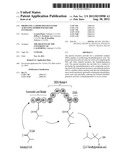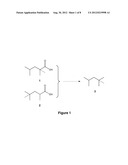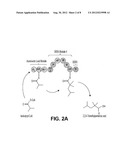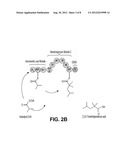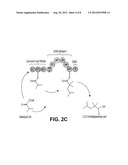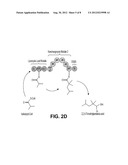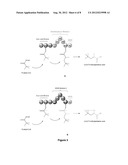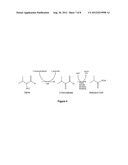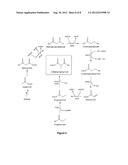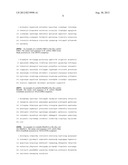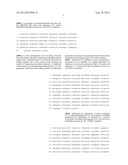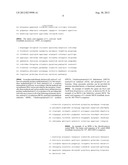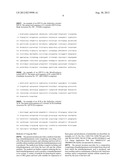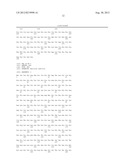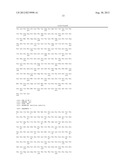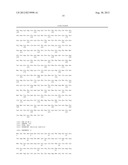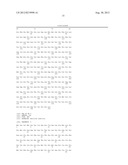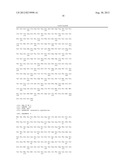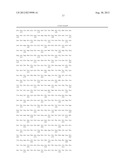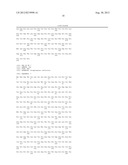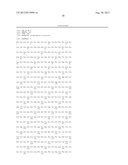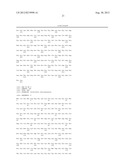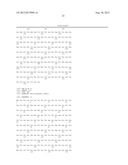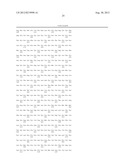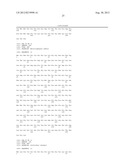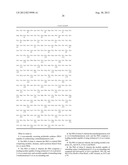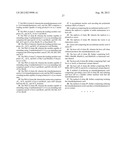Patent application title: Producing a Trimethylpentanoic Acid Using Hybrid Polyketide Synthases
Inventors:
Leonard Katz (Oakland, CA, US)
Leonard Katz (Oakland, CA, US)
Jeffrey L. Fortman (San Francisco, CA, US)
Jeffrey L. Fortman (San Francisco, CA, US)
Jay D. Keasling (Berkeley, CA, US)
Assignees:
THE REGENTS OF THE UNIVERSITY OF CALIFORNIA
IPC8 Class: AC12P740FI
USPC Class:
435136
Class name: Micro-organism, tissue cell culture or enzyme using process to synthesize a desired chemical compound or composition preparing oxygen-containing organic compound containing a carboxyl group
Publication date: 2012-08-30
Patent application number: 20120219998
Abstract:
The present invention provides for a polyketide synthase (PKS) capable of
synthesizing trimethylpentanoic acid. The present invention also provides
for a host cell comprising the PKS and when cultured produces the
trimethylpentanoic acid. The present invention also provides for a method
of producing the trimethylpentanoic acid, comprising: providing a host
cell of the present invention, and culturing said host cell in a suitable
culture medium such that the trimethylpentanoic acid is produced,
optionally isolating the trimethylpentanoic acid, and optionally,
reducing the isolated trimethylpentanoic acid into a trimethylpentanol or
an iso-octane.Claims:
1. A non-naturally occurring polyketide synthase (PKS) capable of
synthesizing a trimethylpentanoic acid.
2. The PKS of claim 1, wherein the PKS is a hybrid PKS comprising modules, domains, and/or portions thereof from two or more PKSs.
3. The PKS of claim 2, wherein the PKS comprises a loading module capable of using isobutyryl-CoA or pivaloyl-CoA as a starter unit, and a module capable of extending using 2-methylmalonyl-CoA as an extending unit.
4. The PKS of claim 3, wherein the trimethylpentanoic acid is 2,2,4-trimethylpentanoic acid, and the PKS comprises a loading module capable of using isobutyryl-CoA as a starter unit.
5. The PKS of claim 4, wherein, the loading module comprises ATL and ACPL of Ave Load-Mod1.
6. The PKS of claim 3, wherein the module capable of extending using 2-methylmalonyl-CoA as an extending unit comprises KS and mmAT of Ave Load-Mod1, DH, ER, and KR of Ery Mod4 or Nan Mod2, a cMT domain, an ACP, and a TE.
7. The PKS of claim 3, wherein the trimethylpentanoic acid is 2,4,4-trimethylpentanoic acid, and the PKS comprises a loading module capable of using pivaloyl-CoA as a starter unit.
8. The PKS of claim 7, wherein the loading module comprises ATL and ACPL of Ave Load-Mod1.
9. The PKS of claim 8, wherein the module capable of extending using 2-methylmalonyl-CoA as an extending unit comprises KS and mmAT of Ave Load-Mod1, and DH, ER, KR, ACP and TE of Ery Mod4-TE or Nan Mod2-TE.
10. The PKS of claim 4, wherein the loading module comprises ATL, ACPL and KS1 of Lipomycin Load Module.
11. The PKS of claim 10, wherein the module capable of extending using 2-methylmalonyl-CoA as an extending unit comprises the following modules: mmAT, DH, ER, KR, cMT, and ACP.
12. The PKS of claim 7, wherein the loading module comprises ATL, ACPL and KS1 of But Load Module of Streptomyces rochei.
13. The PKS of claim 12, wherein the module capable of extending using 2-methylmalonyl-CoA as an extending unit comprises mmAT of Ave Load-Mod1, and DH, ER, KR, ACP of Ery Mod4.
14. The PKS of claim 12, wherein the trimethylpentanoic acid is 2,4,4-trimethylpentanoic acid, and the PKS comprises a loading module capable of using isobutyryl-CoA as a starter unit.
15. The PKS of claim 14, wherein the starter unit comprises ATL, ACPL and KS1 of Ave Load-Mod1, and a cMT domain between the ATL and ACPL domains.
16. The PKS of claim 15, wherein the module capable of extending using 2-methylmalonyl-CoA as an extending unit comprises mmAT of Ave Load-Mod1, and DH, ER, KR, ACP of Ery Mod4.
17. A recombinant nucleic acid encoding the polyketide synthase (PKS) of claim 1.
18. A replicon comprising the recombinant nucleic acid 17, wherein the replicon is capable of stable maintenance in a host cell.
19. The replicon of claim 18, wherein the replicon is a plasmid or vector.
20. The replicon of claim 19, wherein the vector is an expression vector.
21. A host cell comprising the recombinant nucleic acid of claim 17.
22. The host cell of claim 21, wherein the host cell when cultured produces the trimethylpentanoic acid.
23. The host cell of claim 22, further comprising IveE, PdhD, BfmBB, BfmBAA, and BfmBAB, or functional variants thereof.
24. The host cell of claim 22, further comprising PrpE, and PccA or AccB, or functional variants thereof.
25. The host cell of claim 22, further comprising MCR, MSR, HPCS, HPCD, and ACR, or functional variants thereof.
26. A method of producing an trimethylpentanoic acid, comprising: providing a host cell of claim 22, and culturing said host cell in a suitable culture medium such that the trimethylpentanoic acid.
27. The method of claim 26, further comprising isolating the trimethylpentanoic acid.
28. The method of claim 27, further comprising reducing the trimethylpentanoic acid to produce a trimethylpentanol or an iso-octane.
Description:
CROSS-REFERENCE TO RELATED APPLICATIONS
[0001] This application claims priority to U.S. Provisional Patent Application Ser. No. 61/416,133, filed Nov. 22, 2010, which is hereby incorporated by reference.
FIELD OF THE INVENTION
[0003] This invention relates generally to iso-octane production using polyketide synthases.
BACKGROUND OF THE INVENTION
[0004] Iso-octane (such as 2,2,4-trimethylpentane) is one of the most important components in gasoline and is the gasoline component for which the octane rating has been coined. While gasoline has many other components, fuels for piston engine airplanes can be pure iso-octane. The branches in iso-octane give it the appropriate combustion properties for ignition engines. Unfortunately, the branches in iso-octane also make it nearly impossible to produce biologically. Indeed, tertiary butyl carbons exist rarely in nature. The biological production of iso-octane and molecules like it would be extremely valuable to the transportation fuels industry as it would allow direct substitution of these biofuels into the existing transportation and refining infrastructure.
SUMMARY OF THE INVENTION
[0005] The present invention provides for a polyketide synthase (PKS), capable of synthesizing a trimethylpentanoic acid. The PKS is not a naturally occurring PKS. In some embodiments of the invention, the PKS is a hybrid PKS comprising modules, domains, and/or portions thereof from two or more naturally occurring PKSs. The present invention provides for a recombinant nucleic acid that encodes a polyketide synthase (PKS) of the present invention. The recombinant nucleic acid can be replicon capable of stable maintenance in a host cell. In some embodiments, the replicon is stably integrated into a chromosome of the host cell. In some embodiments, the replicon is a plasmid. The present invention also provides for a vector or expression vector comprising a recombinant nucleic acid of the present invention. The present invention provides for a host cell comprising any of the recombinant nucleic acid and/or PKS of the present invention. In some embodiments, the host cell, when cultured under a suitable condition, is capable of producing the trimethylpentanoic acid.
[0006] The present invention provides for a host cell comprising any of the recombinant nucleic acid and/or PKS of the present invention. In some embodiments, the host cell, when cultured, is capable of producing a trimethylpentanoic acid. In some embodiments of the invention, the host cell carries a number of genes that enable the production of 2-methylmalonyl-CoA, a necessary precursor of trimethypentanoic acid biosynthesis.
[0007] The present invention provides a method of producing a trimethylpentanoic acid, comprising: providing a host cell of the present invention, and culturing said host cell in a suitable culture medium such that the trimethylpentanoic acid is produced. The method can further comprise isolating the trimethylpentanoic acid, and optionally, reducing the isolated trimethylpentanoic acid into a trimethylpentanol or an iso-octane.
[0008] The present invention provides for a composition comprising a trimethylpentanoic acid isolated from a host cell from which the trimethylpentanoic acid was produced, and trace residues and/or contaminants of the host cell. Such trace residues and/or contaminants include cellular material produced by the lysis of the host cell. In some embodiments of the invention, the trace residues and/or contaminants do not or essentially do not interfere or retard any further reaction involving the trimethylpentanoic acid.
BRIEF DESCRIPTION OF THE DRAWINGS
[0009] The foregoing aspects and others will be readily appreciated by the skilled artisan from the following description of illustrative embodiments when read in conjunction with the accompanying drawings.
[0010] FIG. 1 shows two routes to production of iso-octane provided by the invention.
[0011] FIG. 2 shows four examples of PKS-A constructs, each designed to produce 2,2,4-trimethylpentanoic acid provided by the invention.
[0012] FIG. 3 shows two examples of PKS-B constructs, each designed to produce 2,4,4-trimethylpentanoic acid provided by the invention.
[0013] FIG. 4 shows a pathway for synthesizing isobutyryl-CoA provided by the invention.
[0014] FIG. 5 shows a pathway for synthesizing 2-methylmalonyl-CoA provided by the invention.
DETAILED DESCRIPTION
[0015] Before the present invention is described, it is to be understood that this invention is not limited to particular embodiments described, as such may, of course, vary. It is also to be understood that the terminology used herein is for the purpose of describing particular embodiments only, and is not intended to be limiting, since the scope of the present invention will be limited only by the appended claims.
[0016] While the present invention has been described with reference to the specific embodiments thereof, it should be understood by those skilled in the art that various changes may be made and equivalents may be substituted without departing from the true spirit and scope of the invention. In addition, many modifications may be made to adapt a particular situation, material, composition of matter, process, process step or steps, to the objective, spirit and scope of the present invention. All such modifications are intended to be within the scope of the claims appended hereto.
[0017] Where a range of values is provided, it is understood that each intervening value, to the tenth of the unit of the lower limit unless the context clearly dictates otherwise, between the upper and lower limits of that range is also specifically disclosed. Each smaller range between any stated value or intervening value in a stated range and any other stated or intervening value in that stated range is encompassed within the invention. The upper and lower limits of these smaller ranges may independently be included or excluded in the range, and each range where either, neither or both limits are included in the smaller ranges is also encompassed within the invention, subject to any specifically excluded limit in the stated range. Where the stated range includes one or both of the limits, ranges excluding either or both of those included limits are also included in the invention.
[0018] Unless defined otherwise, all technical and scientific terms used herein have the same meaning as commonly understood by one of ordinary skill in the art to which this invention belongs. Although any methods and materials similar or equivalent to those described herein can be used in the practice or testing of the present invention, the preferred methods and materials are now described. All publications mentioned herein are incorporated herein by reference to disclose and describe the methods and/or materials in connection with which the publications are cited.
[0019] It must be noted that as used herein and in the appended claims, the singular forms "a", "and", and "the" include plural referents unless the context clearly dictates otherwise. Thus, for example, reference to "a PKS" includes a plurality of such PKSs, and so forth.
[0020] The term "Ave" refers to Avermectin.
[0021] The term "But" refers to Butyrolactol A.
[0022] The term "Ery" refers to Erythromycin.
[0023] The term "DEBS" refers to the Ery PKS.
[0024] The term "Nan" refers to Nanchangmycin.
[0025] The term "Lip" refers to Lipomycin.
[0026] The term "functional variant" describes an enzyme that has a polypeptide sequence that is at least 70%, 75%, 80%, 85%, 90%, 95% or 99% identical to any one of the enzymes described herein. The "functional variant" enzyme may retain amino acids residues that are recognized as conserved for the enzyme, and may have non-conserved amino acid residues substituted or found to be of a different amino acid, or amino acid(s) inserted or deleted, but which does not affect or has insignificant effect its enzymatic activity as compared to the enzyme described herein. The "functional variant" enzyme has an enzymatic activity that is identical or essentially identical to the enzymatic activity of the enzyme described herein. The "functional variant" enzyme may be found in nature or be an engineered mutant thereof.
[0027] These and other objects, advantages, and features of the invention will become apparent to those persons skilled in the art upon reading the details of the invention as more fully described below.
Polyketide Synthases (PKS)
[0028] The present invention provides for a polyketide synthase (PKS) capable of synthesizing a trimethyl pentanoic acid. The PKS is not a naturally occurring PKS. In some embodiments of the invention, the PKS is a hybrid PKS comprising modules, domains, and/or portions thereof from two or more PKSs. In some embodiments of the invention, the trimethyl pentanoic acid is 2,2,4-trimethyl pentanoic acid or 2,4,4-trimethyl pentanoic acid.
[0029] Complex polyketides comprise a large class of natural products that are synthesized in bacteria (mainly members actinomycete family; e.g. Streptomyces), fungi and plants. Polyketides form the aglycone component of a large number of clinically important drugs, such as antibiotics (e.g. erythromycin, tylosin), antifungal agents (e.g. nystatin), anticancer agents (e.g. epothilone), immunosuppressives (e.g. rapamycin), etc. Though these compounds do not resemble each other either in their structure or their mode of action, they share a common basis for their biosynthesis, which is carried out by a group of enzymes designated polyketide synthases.
[0030] Polyketide synthases (PKS) employ short chain fatty acyl-CoAs in Claisen condensation reactions to produce polyketides. Unlike fatty acid synthases which utilize acetyl CoA as the starter and malonyl-CoA as the extender units, and use a single module iteratively to produce the nascent acyl chains, PKSs are composed of discrete modules, each catalyzing the chain growth of a single step. Modules can differ from each other in composition so that overall, a number of different starters (e.g. acetyl-CoA, propionyl-CoA, isobutyryl-CoA) and extenders, some of which contain stereospecific methyl (or ethyl) side chains can be incorporated. In addition, PKS modules do not always reduce the 3-carbonyl formed from condensation but may leave it either unreduced (ketone), partially reduced (hydroxyl, 2,3-ene) or fully reduced (3-methylene). Many polyketide synthases employ malonyl-CoA or [S]-2-methylmalonyl-CoA as the starter for polyketide synthesis. In such cases the terminal carboxyl group is usually removed by a decarboxylase domain present at the N-terminus of the corresponding loading domain of the PKS. In summary, the structure (and chirality) of the α-carbon and β-carbonyl is determined by the module of the PKS employed in the synthesis of the growing chain at each particular step. Because of the correspondence between use of modules in the synthesis and the structure of the polyketide produced, it is possible to program the synthesis to produce a compound of desired structure by selection and genetic manipulation of polyketide synthases.
[0031] All extender modules carry the β-acyl ACP synthase (commonly called the ketosynthase or KS) domain, which conducts the decarboxylative condensation step between the extender and the growing polyketide chain, and the acyl carrier protein (ACP) domain that carries the growing acyl chain and presents it to the cognate reductive domains for reduction of the β-carbonyl. Modules can differ from each other in composition so that a number of different starter and extender units, some of which contain stereospecific side chains (e.g. methyl, ethyl, propylene) can be incorporated. The acyltransferase (AT) domain of each module determines the extender unit (e.g. malonyl-CoA, methylmalonyl-CoA, etc.) incorporated. In addition, PKS modules do not always reduce the β-carbonyl formed from condensation but may leave it either unreduced (ketone), partially reduced (hydroxyl, 2,3-ene) or fully reduced (3-methylene), as shown in FIG. 2. The ketoreductase (KR) domain reduces the ketone to the OH function (stereospecifically); the dehydratase (DH) domain removes water from the α and β carbons leaving an α,β trans-double bond; the enoylreductase (ER) domain reduces the double bond to a β-methylene center; the reductive state of the β-carbonyl, therefore, is determined by the presence of functional reductive domains in the corresponding module. Less commonly, modules are found to contain an additional C-methylation domain (yielding an additional α-methyl side chain, as in epothilone). The makeup of the PKS, therefore, determines the choice of starter and extender acyl units incorporated, the extent of reduction at each condensation step, and the total number of units added to the chain. The wide diversity of structures of polyketides seen in nature is attributed to the diversity in PKS compositions.
[0032] A partial list of sources of PKS sequences that can be used in making the PKSs of the present invention, for illustration and not limitation, includes Ambruticin (U.S. Pat. No. 7,332,576); Avermectin (U.S. Pat. No. 5,252,474; MacNeil et al., 1993, Industrial Microorganisms: Basic and Applied Molecular Genetics, Baltz, Hegeman, & Skatrud, eds. (ASM), pp. 245-256; MacNeil et al., 1992, Gene 115: 119-25); Candicidin (FRO008) (Hu et al., 1994, Mol. Microbiol. 14: 163-72); Epothilone (U.S. Pat. No. 6,303,342); Erythromycin (WO 93/13663; U.S. Pat. No. 5,824,513; Donadio et al., 1991, Science 252:675-79; Cortes et al., 1990, Nature 348:176-8); FK506 (Motamedi et al., 1998, Eur. J. Biochem. 256:528-34; Motamedi et al., 1997, Eur. J. Biochem. 244:74-80); FK520 or ascomycin (U.S. Pat. No. 6,503,737; see also Nielsen et al., 1991, Biochem. 30:5789-96); Jerangolid (U.S. Pat. No. 7,285,405); Leptomycin (U.S. Pat. No. 7,288,396); Lovastatin (U.S. Pat. No. 5,744,350); Nanchangmycin (Sun et al., 2002, Microbiology, 148: 361-71; Nemadectin (MacNeil et al., 1993, supra); Niddamycin (Kakavas et al., 1997, J. Bacteriol. 179:7515-22); Oleandomycin (Swan et al., 1994, Mol. Gen. Genet. 242:358-62; U.S. Pat. No. 6,388,099; Olano et al., 1998, Mol. Gen. Genet. 259:299-308); Pederin (PCT publication no. WO 2003/044186); Pikromycin (Xue et al., 2000, Gene 245:203-211); Pimaricin (PCT publication no. WO 2000/077222); Platenolide (EP Pat. App. 791,656); Rapamycin (Schwecke et al., 1995, Proc. Natl. Acad. Sci. USA 92:7839-43); Aparicio et al., 1996, Gene 169:9-16); Rifamycin (August et al., 1998, Chemistry & Biology, 5: 69-79); Soraphen (U.S. Pat. No. 5,716,849; Schupp et al., 1995, J. Bacteriology 177: 3673-79); Spiramycin (U.S. Pat. No. 5,098,837); Tylosin (EP 0 791,655; Kuhstoss et al., 1996, Gene 183:231-36; U.S. Pat. No. 5,876,991). Additional suitable PKS coding sequences are readily available to one skilled in the art, or remain to be discovered and characterized, but will be available to those of skill (e.g., by reference to GenBank). Each of the references cited is hereby specifically and individually incorporated by reference.
[0033] Of the more than thirty PKSs examined, the correspondence between use of modules in the biosynthesis and the structure of the polyketide produced is fully understood both at the level of the protein sequence of the PKS and the DNA sequence of the corresponding genes. The programming of modules into polyketide structure can be identified by sequence determination. It is possible to clone (or synthesize) DNA sequences corresponding to desired modules and transfer them as fully functioning units to heterologous, otherwise non-polyketide producing hosts such as E. coli (B. A. Pfeifer, S. J. Admiraal, H. Gramajo, D. E. Cane, C. Khosla, Science 291, 1790 (2001); hereby incorporated by reference) and Streptomyces (C. M. Kao, L. Katz, C. Khosla, Science 265, 509 (1994); hereby incorporated by reference). Additional genes employed for polyketide biosynthesis have also been identified. Genes that determine phosphopantetheine:protein transferase (PPTase) that transfer the 4-phosphopantetheine co-factor of the ACP domains, commonly present in polyketide producing hosts, have been cloned in E. coli and other hosts (K. J. Weissman, H. Hong, M. Oliynyk, A. P. Siskos, P. F. Leadlay, Chembiochem 5, 116 (2004); hereby incorporated by reference). It is also possible to re-program polyketide biosynthesis to produce a compound of desired structure by either genetic manipulation of a single PKS or by construction of a hybrid PKS composed of modules from two or more sources (K. J. Weissman, H. Hong, M. Oliynyk, A. P. Siskos, P. F. Leadlay, Chembiochem 5, 116 (2004); hereby incorporated by reference).
[0034] Recombinant methods for manipulating modular PKS genes are described in U.S. Pat. Nos. 5,672,491; 5,843,718; 5,830,750; 5,712,146; and 6,303,342; and in PCT publication nos. WO 98/49315 and WO 97/02358; hereby incorporated by reference. A number of genetic engineering strategies have been used with various PKSs to demonstrate that the structures of polyketides can be manipulated to produce novel polyketides (see the patent publications referenced supra and Hutchinson, 1998, Curr. Opin. Microbiol. 1:319-329, and Baltz, 1998, Trends Microbiol. 6:76-83; hereby incorporated by reference). In some embodiments, the components of the hybrid PKS are arranged onto polypeptides having interpolypeptide linkers that direct the assembly of the polypeptides into the functional PKS protein, such that it is not required that the PKS have the same arrangement of modules in the polypeptides as observed in natural PKSs. Suitable interpolypeptide linkers to join polypeptides and intrapolypeptide linkers to join modules within a polypeptide are described in PCT publication no. WO 00/47724, hereby incorporated by reference.
[0035] TEs capable of releasing free acids as described here include the TE of the eryPKS and MonCII from the monensin pathway in Streptomyces cinnamonensis. The vast number of polyketide pathways that have been elucidated provide a host of different options to produce the desired products as well as the large number of derivatives. The exact interfaces between non-cognate enzyme partners will be determined on a case-by-case basis. ACP-linker-KS and ACP-linker-TE regions from the proteins of interest will be aligned to examine the least disruptive fusion point for the hybrid synthase. Genetic constructions will employ sequence and ligation independent cloning (SLIC) so as to eliminate the incorporation of genetic "scarring".
[0036] In some embodiments of the invention, the polyketide synthase (PKS) is capable of synthesizing 2,2,4-trimethylpentanoic acid (compound 1, FIG. 1) and the PKS comprises a loading module capable of using isobutyryl-CoA as a starter unit, and a module capable of extending using 2-methylmalonyl-CoA as an extending unit. In some embodiments of the invention, the loading module capable of using isobutyryl-CoA as a starter unit comprises ATL and ACPL of Ave Load-Mod1. In some embodiments of the invention, the module capable of extending using 2-methylmalonyl-CoA as an extending unit comprises KS and mmAT of Ave Load-Mod1, DH, ER, and KR of DEBS Mod4 or Nan Mod2, a cMT domain, an ACP and a TE. In some embodiments of the invention, the PKS comprises the structure depicted in FIG. 2A or FIG. 2B.
[0037] In some embodiments of the invention, the polyketide synthase (PKS) is capable of synthesizing 2,4,4-tri compound 2 and the PKS comprises a loading module capable of using pivaloyl-CoA as a starter unit, and a module capable of extending using 2-methylmalonyl-CoA as an extending unit. In some embodiments of the invention, the loading module capable of using pivaloyl-CoA as a starter unit comprises ATL and ACPL of Ave Load-Mod1. In some embodiments of the invention, the module capable of extending using 2-methylmalonyl-CoA as an extending unit comprises KS and mmAT of Ave Load-Mod1, and DH, ER, KR, ACP and TE of DEBS Mod4-TE or Nan Mod2-TE. In some embodiments of the invention, the PKS comprises one of the structures depicted in FIG. 3.
[0038] In some embodiments of the invention, the polyketide synthase (PKS) is capable of synthesizing compound 1 and the PKS comprises a loading module capable of using isobutyryl-CoA as a starter unit, a module capable of extending using 2-methylmalonyl-CoA as an extending unit, and a TE. In some embodiments of the invention, the loading module capable of using isobutyryl-CoA as a starter unit comprises ATL, ACPL and KS1 of Lipomycin Load Module. In some embodiments of the invention, the module capable of extending using 2-methylmalonyl-CoA as an extending unit comprising the following modules: mmAT, DH, ER, KR, cMT, and ACP. The mmAT can be the mmAT of Ave Load-Mod1. The DH, ER, KR can be DEBS Mod4 or Nan Mod2. The cMT domain can be any suitable cMT. The TE can be any suitable TE, such as an Ery TE. In some embodiments of the invention, the PKS comprises the structure depicted in FIG. 2C or FIG. 2D. In a particular embodiment, the KS domain of module 1 is the KS domain that is immediately downstream of the ACP domain of the loading module. For example, as shown in FIG. 2A or FIG. 2B, if the loading module is from the ave PKS, the KS domain of module 1 is from module 1 of the ave PKS. The region between the ACP of the loading module and the KS1 domain is therefore preserved as in the natural PKS to ensure that both the contact between the two ACP and KS domains and the transfer of the isobutyryl moiety from ACP to KS is maintained, as in the natural system.
[0039] In some embodiments of the invention, the polyketide synthase (PKS) is capable of synthesizing compound 2 and the PKS comprises a loading module capable of using pivaloyl-CoA as a starter unit, a module capable of extending using 2-methylmalonyl-CoA as an extending unit, and a TE. In some embodiments of the invention, the loading module capable of using pivaloyl-CoA as a starter unit comprises ATL, ACPL and KS1 of Ave Load-Mod 1. In other embodiments of the invention, the loading module capable of using pivaloyl-CoA as a starter unit comprises ATL, ACPL and KS1 of But Load Module of Streptomyces rochei. In some embodiments of the invention, the module capable of extending using 2-methylmalonyl-CoA as an extending unit comprises mmAT of Ave Load-Mod 1, and DH, ER, KR, ACP of Ery Mod4. The TE can be any suitable TE, such as an Ery TE. In some embodiments of the invention, the PKS comprises the structure depicted in FIG. 3A or FIG. 3B.
[0040] In some embodiments of the invention, the polyketide synthase (PKS) is capable of synthesizing compound 2 and the PKS comprises a loading module capable of using isobutyryl-CoA as a starter unit, a module capable of extending using 2-methylmalonyl-CoA as an extending unit, and a TE. In some embodiments of the invention, the loading module capable of using isobutyryl-CoA as a starter unit comprises ATL, ACPL and KS1 of Ave Load-Mod1, and a cMT domain between the ATL and ACPL domains. In some embodiments of the invention, the module capable of extending using 2-methylmalonyl-CoA as an extending unit comprises mmAT of Ave Load-Mod1, and DH, ER, KR, ACP of DEBS Mod4 or Nan Mod2. The TE can be any suitable TE, such as an Ery TE. In some embodiments of the invention, the PKS comprises the structure depicted in FIG. 3.
Nucleic Acids Encoding the PKS
[0041] The present invention provides for a recombinant nucleic acid that encodes a polyketide synthase (PKS) of the present invention. The recombinant nucleic acid can be a double-stranded or single-stranded DNA, or RNA. The recombinant nucleic acid can encode an open reading frame (ORF) of the PKS of the present invention. The recombinant nucleic acid can also comprise promoter sequences for transcribing the ORF in a suitable host cell. The recombinant nucleic acid can also comprise sequences sufficient for having the recombinant nucleic acid stably replicate in a host cell. The recombinant nucleic acid can be replicon capable of stable maintenance in a host cell. In some embodiments, the replicon is stably integrated into a chromosome of the host cell. In some embodiments, the replicon is a plasmid. The present invention also provides for a vector or expression vector comprising a recombinant nucleic acid of the present invention. The present invention provides for a host cell comprising any of the recombinant nucleic acid and/or PKS of the present invention. In some embodiments, the host cell, when cultured under a suitable condition, is capable of producing the trimethylpentanoic acid.
[0042] It will be apparent to one of skill in the art that a variety of recombinant vectors can be utilized in the practice of aspects of the invention. As used herein, "vector" refers to polynucleotide elements that are used to introduce recombinant nucleic acid into cells for either expression or replication. Selection and use of such vehicles is routine in the art. An "expression vector" includes vectors capable of expressing DNAs that are operatively linked with regulatory sequences, such as promoter regions. Thus, an expression vector refers to a recombinant DNA or RNA construct, such as a plasmid, a phage, recombinant virus or other vector that, upon introduction into an appropriate host cell, results in expression of the cloned DNA. Appropriate expression vectors are well known to those of skill in the art and include those that are replicable in eukaryotic cells and/or prokaryotic cells and those that remain episomal or those that integrate into the host cell genome.
[0043] The vectors may be chosen to contain control sequences operably linked to the resulting coding sequences in a manner that expression of the coding sequences may be effected in an appropriate host. Suitable control sequences include those that function in eukaryotic and prokaryotic host cells. If the cloning vectors employed to obtain PKS genes encoding derived PKS lack control sequences for expression operably linked to the encoding nucleotide sequences, the nucleotide sequences are inserted into appropriate expression vectors. This can be done individually, or using a pool of isolated encoding nucleotide sequences, which can be inserted into host vectors, the resulting vectors transformed or transfected into host cells, and the resulting cells plated out into individual colonies. Suitable control sequences for single cell cultures of various types of organisms are well known in the art. Control systems for expression in suitable host cells, such as yeast and prokaryotic host cells, are widely available and are routinely used. Control elements include promoters, optionally containing operator sequences, and other elements depending on the nature of the host, such as ribosome binding sites. Particularly useful promoters for prokaryotic hosts include those from PKS gene clusters that result in the production of polyketides as secondary metabolites, including those from Type I or aromatic (Type II) PKS gene clusters. Examples are act promoters, tcm promoters, spiramycin promoters, and the like. However, other bacterial promoters, such as those derived from sugar metabolizing enzymes, such as galactose, lactose (lac) and maltose, are also useful. Additional examples include promoters derived from biosynthetic enzymes such as for tryptophan (trp), the β-lactamase (bla), bacteriophage lambda PL, and T5. In addition, synthetic promoters, such as the tac promoter (U.S. Pat. No. 4,551,433; hereby incorporated by reference), can be used.
[0044] As noted, particularly useful control sequences are those which themselves, or with suitable regulatory systems, activate expression during transition from growth to stationary phase in the vegetative mycelium. Illustrative control sequences, vectors, and host cells of these types include the modified Streptomyces coelicolor CH999 and vectors described in PCT publication no. WO 96/40968 and similar strains of Streptomyces lividans. See U.S. Pat. Nos. 5,672,491; 5,830,750; 5,843,718; and 6,177,262, each of which is hereby incorporated by reference. Other regulatory sequences may also be desirable which allow for regulation of expression of the PKS sequences relative to the growth of the host cell. Regulatory sequences are known to those of skill in the art, and examples include those which cause the expression of a gene to be turned on or off in response to a chemical or physical stimulus, including the presence of a regulatory compound. Other types of regulatory elements may also be present in the vector, for example, enhancer sequences.
[0045] Selectable markers can also be included in the recombinant expression vectors. A variety of markers are known which are useful in selecting for transformed cell lines and generally comprise a gene whose expression confers a selectable phenotype on transformed cells when the cells are grown in an appropriate selective medium. Such markers include, for example, genes that confer antibiotic resistance or sensitivity to the plasmid.
[0046] The various PKS nucleotide sequences, or a mixture of such sequences, can be cloned into one or more recombinant vectors as individual cassettes, with separate control elements or under the control of a single promoter. The PKS subunits or components can include flanking restriction sites to allow for the easy deletion and insertion of other PKS subunits. The design of such restriction sites is known to those of skill in the art and can be accomplished using the techniques described above, such as site-directed mutagenesis and PCR. Methods for introducing the recombinant vectors of the present invention into suitable hosts are known to those of skill in the art and typically include the use of CaCl2 or other agents, such as divalent cations, lipofection, DMSO, protoplast transformation, conjugation, and electroporation.
Host Cells Comprising the PKS
[0047] The present invention provides for a host cell comprising any of the recombinant nucleic acid and/or PKS of the present invention. In some embodiments, the host cell, when cultured, is capable of producing the trimethylpentanoic acid. The host cell can be a eukaryotic or a prokaryotic cell. Suitable eukaryotic cells include yeast cells, such as from the genus Saccharomyces or Schizosaccharomyces. A suitable species from the genus Saccharomyces is Saccharomyces cerevisiae. A suitable species from the genus Schizosaccharomyces is Schizosaccharomyces pombe. Suitable prokaryotic cells include Escherichia coli or Streptomyces species.
[0048] Production of polyketides in a host cell, such as E. coli, employing natural or synthetic PKSs has been achieved previously (Menzella, H. G., S. J. Reisinger, M. Welch, J. T. Kealey, J. Kennedy, R. Reid, C. Q. Tran, and D. V. Santi. 2006. Redesign, synthesis and functional expression of the 6-deoxyerythronolide B polyketide synthase gene cluster. J Ind Microbiol Biotechnol 33:22-8; Pfeifer, B. A., S. J. Admiraal, H. Gramajo, D. E. Cane, and C. Khosla. 2001. Biosynthesis of complex polyketides in a metabolically engineered strain of E. coli. Science 291:1790-2; incorporated by reference herein). One skilled in the art can use E. coli 207-3 (Lau, J., C. Tran, P. Licari, and J. Galazzo. 2004. Development of a high cell-density fed-batch bioprocess for the heterologous production of 6-deoxyerythronolide B in E. coli. J Biotechnol 110:95-103; incorporated by reference herein) or an engineered derivative for production of compound 1 or 2. This strain contains the genes sfp, encoding the activity required for phophopantetheinylation of the ACP domains of PKS-A and PKS-B, as well as prpE, encoding propionyl-CoA synthetase, that converts propionate to propionyl-CoA, accA-pccB, which encodes the enzyme complex that converts propionyl-CoA to 2S-methylmalonyl-CoA, the extender substrate used for PKS-A and PKS-B.
[0049] The PKS can be in a host cell, or isolated or purified. The PKS can synthesize the trimethylpentanoic acid in vivo (in a host cell) or in vitro (in a cell extract or where all necessary chemical components or starting materials are provided). The present invention provides methods of producing the trimethylpentanoic acid using any of these in vivo or in vitro means.
[0050] In some embodiments of the invention, when the host cell comprises the PKS comprising a loading module which loads a pivaloyl-CoA, when the host cell can further comprise one or more nucleic acids encoding and capable of expressing biosynthetic enzymes for synthesizing pivaloyl-CoA, or when the host cell is cultured pivaloyl-CoA can be exogenously fed to the host cell by having pivalate being present in the culture medium. All hosts contain short chain acyl-CoA synthetases that catalyze the conversion of pivalate into pivaloyl-CoA.
[0051] In some embodiments of the invention, when the host cell comprises the PKS comprising a loading module which loads a pivaloyl-CoA, when the host cell can further comprise one or more nucleic acids encoding and capable of expressing biosynthetic enzymes for synthesizing isobutyryl-CoA and a SAM-dependent isobutyryl-CoA methyltransferase. The host cell can either further comprise one or more nucleic acids encoding and capable of expressing biosynthetic enzymes, or functional variants thereof, for synthesizing isobutyryl-CoA, or when the host cell is cultured isobutyryl-CoA can be exogenously fed to the host cell by having isobutyrate being present in the culture medium. The SAM-dependent isobutyrl-CoA methyltransferase catalyzes the following reaction:
##STR00001##
[0052] In some embodiments of the invention, when the host cell comprises the PKS comprising a loading module which loads an isobutyryl-CoA, when the host cell can further comprise one or more nucleic acids encoding and capable of expressing biosynthetic enzymes for synthesizing isobutyryl-CoA, or when the host cell is cultured isobutyryl-CoA can be exogenously fed to the host cell by having isobutyrate being present in the culture medium. See FIG. 5.
[0053] Isobutyryl-CoA can be synthesized from valine using the following enzymes: IlvE, PdhD, BfmBB, BfmBAA, and BfmBAB, or functional variants thereof.
[0054] Isobutyryl-CoA can be synthesized from 2-oxovalerate using the following enzymes: PdhD, BfmBB, BfmBAA, and BfmBAB or functional variants thereof.
[0055] An example of a suitable IlvE is E. coli IlvE. The amino acid sequence of E. coli IlvE (GenBank accession no. AAA24022) comprises:
TABLE-US-00001 1 mttkkadyiw fngemvrwed akvhvmshal hygtsvfegi rcydshkgpv vfrhrehmqr 61 lhdsakiyrf pvsqsidelm eacrdvirkn nitsayirpl ifvgdvgmgv nppagystdv 121 iiaafpwgay lgaealeqgi damvsswnra apntiptaak aggnylssll vgsearrhgy 181 qegialdvng yisegagenl fevkdgvlft ppftssalpg itrdaiikla kelgievreq 241 vlsreslyla devfmsgtaa eitpvrsvdg iqvgegrcgp vtkriqqaff glftgetedk 301 wgwldqvnq
[0056] An example of a suitable PdhD is Bacillus subtilis PdhD. The amino acid sequence of B. subtilis PdhD (GenBank accession no. AAC24935) comprises:
TABLE-US-00002 1 mvvgdfpiet dtlvigagpg gyvaairaaq lgqkvtvvek atlggvclnv gcipskalin 61 aghryenakh sddmgitaen vtvdftkvqe wkasvvnklt ggvagllkgn kvdvvkgeay 121 fvdsnsvrvm densaqtytf knaiiatgsr pielpnfkys ervlnstgal alkeipkklv 181 vigggyigte lgtayanfgt elvileggde ilpgfekqms slvtrrlkkk gnveihtnam 241 akgveerpdg vtvtfevkge ektvdadyvl itvgrrpntd elgleqvgie mtdrgivktd 301 kqcrtnvpni yaigdiiegp plahkasyeg kiaaeaiage paeidylgip avvfsepela 361 svgyteaqak eegldivaak fpfaangral slnetdgfmk litrkedglv igaqiagasa 421 miselsla ieggmtaedi amtihahptl geitmeaaev aigspihivk
[0057] An example of a suitable BfmBB is Bacillus subtilis BfmBB. The amino acid sequence of B. subtilis BfmBB (GenBank accession no. BAA12600) comprises:
TABLE-US-00003 1 maieqmtmpq lgesvtegti skwlvapgdk vnkydpiaev mtdkvnaevp ssftgtitel 61 vgeegqtlqv gemickiete ganpaeqkqe qpaaseaaen pvaksagaad qpnkkryspa 121 vlrlagehgi dldqvtgtga ggritrkdiq rlietggvqe qnpeelktaa papksaskpe 181 pkeetsypas aagdkeipvt gvrkaiasnm krskteipha wtmmevdvtn mvayrnsikd 241 sfkktegfnl tffaffvkav aqalkefpqm nsmwagdkii qkkdinisia vatedslfvp 301 viknadekti kgiakditgl akkvrdgklt addmqggtft vnntgsfgsv qsmgiinypq 361 aailqvesiv krpvvmdngm iavrdmvnlc lsldhrvldg lvcgrflgry kqilesidek 421 tsvy
[0058] An example of a suitable BfmBAA is Bacillus subtilis BfmBAA. The amino acid sequence of B. subtilis BfmBAA (GenBank accession no. BAA12598) comprises:
TABLE-US-00004 1 mstnrhgalg ltdqeavdmy rtmllarkid ermwllnrsg kipfviscqg qeaaqvgaaf 61 aldremdyvl pyyrdmgvvl afgmtakdlm msgfakaadp nsggrqmpgh fgqkknrivt 121 gsspvttqvp havgialagr mekkdiaafv tfgegssnqg dfheganfaa vhklpvifmc 181 ennkyaisvp ydkqvaceni sdraigygmp gvtvngndpl evyqavkear erarrgegpt 241 lietisyrlt phssddddss yrgreeveea kksdplltyq aylketglls deieqtmlde 301 imaivneatd eaenapyaap esaldyvyak
[0059] An example of a suitable BfmBAB is Bacillus subtilis BfmBAB. The amino acid sequence of B. subtilis BfmBAB (GenBank accession no. BAA12599) comprises:
TABLE-US-00005 1 msvmsyidai nlamkeemer dsrvfvlged vgrkggvfka taglyeqfge ervmdtplae 61 saiagvgiga amygmrpiae mgfadfimpa vnqiiseaak iryrsnndws cpivvrapyg 121 ggvhgalyhs qsveaifanq pglkivmpst pydakgllka avrdedpvlf fehkrayrli 181 kgevpaddyv lpigkadvkr egdditvity glcvhfalqa aerlekdgis ahvvdlrtvy 241 pldkeaiiea asktgkvllv tedtkegsim sevaaiiseh clfdldapik rlagpdipam 301 aptmekyf mvnpdkveaa mrelaef
[0060] In some embodiments of the invention, when the host cell comprises the PKS comprising an extending module which loads a methylmalonyl-CoA, when the host cell can further comprise one or more nucleic acids encoding and capable of expressing biosynthetic enzymes, or functional variants thereof, for synthesizing methylmalonyl-CoA from propionate, and the host cell is either capable of synthesizing propionate or propionate is exogenously fed to the host cell by having propionate being present in the culture medium.
[0061] Propionyl-CoA synthetase converts propionate to propionyl-CoA. An example of a suitable propionyl-CoA synthetase is Salmonella typhimurium PrpE. The amino acid sequence of S. typhimurium PrpE (GenBank accession no. AAC44817) comprises:
TABLE-US-00006 1 msfsefyqrs inepeafwae qarridwrqp ftqtldhsrp pfarwfcggt tnlchnavdr 61 wrdkqpeala liayssetde ertftfsqlh devnivaaml lslgvqrgdr vlvympmiae 121 aqitllacar igaihsvvfg gfashsvaar iddarpaliv sadagarggk ilpykklldd 181 aiaqaqhqpk hvllvdrgla kmawvdgrdl dfatlrqqhl gasvpvawle snetscilyt 241 sgttgkpkgv qrdvggyava latsmdtifg gkaggvffca sdigwvvghs yivyapllag 301 mativyeglp typdcgvwwk ivekyqvnrm fsaptairvl kkfptaqirn hdlsslealy 361 lagepldept aswvtetlgv pvidnywqte sgwpimalar alddrpsrlg spgvpmygyn 421 vqllnevtge pcginekgml viegplppgc iqtiwgddar fvktywslfn rqvyatfdwg 481 irdaegyyfi lgrtddvini aghrlgtrei eesissypnv aevavvgikd alkgqvavaf 541 vipkqsdtla dreaardeen aimalvdnqi ghfgrpahvw fvsqlpktrs gkmlrrtiqa 601 icegrdpgdl ttiddpaslq qirqaiee
[0062] Propionyl-CoA carboxylase converts propionyl-CoA to 2[S]-methylmalonyl-CoA. An example of a suitable propionyl-CoA carboxylase is Streptomyces coelicolor PccA/AccB. The amino acid sequence of S. coelicolor PccA (GenBank accession no. NP--627007) comprises:
TABLE-US-00007 1 mfdtvlvanr geiavrvirt lrsmgvrsva vfsdadadar hvreaddavr igpapatesy 61 lsverllaaa artgaqavhp gygflaenag faraceeagl vfigpsadai almgdkirak 121 etvraagvpv vpgssgsglt deqladaare igtpvllkps aggggkgmrl vrdtavlade 181 iaaarreara sfgddtllve rwidrprhie iqvladghgg vvhlgerecs lqrrhqkvie 241 eapsvlldea traamgeaav qaarscgyrg agtvefivpg sdpsqyyfme mntrlqvehp 301 vtelvtgldl vewqlrvaag eplgfgqedv rltghaiear lcaedpargf lpsggtvlrl 361 repegdgvrt dsglsegtev gslydpmlsk viaygpdret alrrlraala gtvtlgvqtn 421 agflrrllah pavvageldt glverevdgl vatdvpeevy eaaaavrlea lrprgdgwtd 481 pfsvpsgwrm ggepkaaafh lrvtdpveht prgthtvtgd rvtvtldgvr htfhraadwl 541 grdgdawqvr dhdpvaasln rsahagadsl tapmpgtvtv vkvavgdevs agqsllvvea 601 mkmehvisap hagtvaeldv apgttvamdq vlaviaptdd ateeta
[0063] The amino acid sequence of S. coelicolor AccB (GenBank accession no. 1XNV_A) comprises:
TABLE-US-00008 1 msepeeqqpd ihttagklad lrrrieeath agsaravekq hakgkltare ridllidegs 61 fveldefarh rstnfgldan rpygdgvvtg ygtvdgrpva vfsqdftvfg galgevygqk 121 ivkvmdfalk tgcpvvgind sggariqegv aslgaygeif rrnthasgvi pqislvvgpc 181 aggavyspai tdftvmvdqt shmfitgpdv iktvtgedvg feelggarth nstsgvahhm 241 agdekdavey vkqllsylps nnlseppafp eeadlavtde daeldtivpd sanqpydmhs 301 viehvlddae ffetqplfap niltgfgrve grpvgivanq pmqfagcldi tasekaarfv 361 rtcdafnvpv ltfvdvpgfl pgvdqehdgi irrgaklifa yaeatvplit vitrkafgga 421 ydvmgskhlg adlnlawpta qiavmgagga vnilhrrtia dagddaeatr arliqeyeda 481 llnpytaaer gyvdavimps dtrrhivrgl rqlrtkresl ppkkhgnipl
[0064] In another embodiment, the host cell, such as E. coli, does not naturally produce methylmalonyl-CoA, but can produce methylmalonyl-CoA from malonyl-CoA, a common intermediate in all hosts, in accordance with the methods and recombinant DNA vectors provided by the invention. Generally, these methods and vectors enable a host cell that does not produce methylmalonyl-CoA to produce it by providing that cell with one or more or all of the following enzymatic activities: malonyl-CoA reductase (MCR), malonate semialdehyde reductase (MSR), 3-hydroxypropionyl-CoA synthase (HPCS), 3-hydroxypropionyl-CoA dehydratase (HPCD), acryloyl-CoA reductase (ACR), and propionyl-CoA carboxylase. These enzymatic activities can be provided by enzymes described herein, or functional variants thereof.
[0065] An example of suitable Pcc genes are PccA and AccB from Streptomyces coelicolor, as shown in FIG. 5. An example of an MCR is the Sulfolobus tokodaii MCR. The amino acid sequence of S. tokodaii MCR (GenBank Accession No. NP 378167) comprises:
TABLE-US-00009 1 milmrrtlka ailgatglvg ieyvrmlsnh pyikpaylag kgsvgkpyge vvrwqtvgqv 61 pkeiadmeik ptdpklmddv diifsplpqg aagpveeqfa kegfpvisns pdhrfdpdvp 121 llvpelnpht islideqrkr rewkgfivtt plctaqgaai plgaifkdyk mdgafittiq 181 slsgagypgi psldvvdnil plgdgydakt ikeifrilse vkrnvdepkl edvslaatth 241 riatihghye vlyvsfkeet aaekvketle nfrgepqdlk lptapskpii vmnedtrpqv 301 yfdrwagdip gmsvvvgrlk qvnkrmirlv slihntvrga agggilaael lvekgyiek.
[0066] An example of an MSR is the Metallosphaera sedula MSR. The amino acid sequence of M. sedula MSR (GenBank Accession No. YP--001192057) comprises:
TABLE-US-00010 1 mtekvsvvga gvigvgwatl faskgysysl ytekketldk gieklrnyvq vmknnsqite 61 dvntvisrvs pttnldeavr ganfvieavi edydakkkif gyldsvldke vilasstsgl 121 litevqkams khperaviah pwnpphllpl veivpgekts mevvertksl mekldrivvv 181 lkkeipgfig nrlafalfre avylvdegva tvedidkvmt aaiglrwafm gpfltyhlgg 241 geggleyffn rgfgyganew mhtlakydkf pytgvtkaiq qmkeysfikg ktfqeiskwr 301 dekllkvykl vwek.
[0067] An example of an HPCS is the Sulfolobus tokodaii HPCS. The amino acid sequence of S. tokodaii HPCS (GenBank Accession No. NP--376686) comprises:
TABLE-US-00011 1 mteklseqlq qlgeqnleek adynmryyky lykksieepd kfwgelaeel itwyepwkqa 61 fvqeeglltk wfvggklnas ynavdrhlns hrkykaaifw esekgekkvv tyqdlfyevn 121 kwanalrelg vkkgdrvtiy mpltpegvia klavarlgai hsvvfagfga qaladriada 181 gakvvitada yyrrgklvel kktvdealni lgdkspvqkv lvykrtgtei pfkegrdvyf 241 devgkykyie pvpveatepl filytsgttg kpkgivhstg gylvgtavml lwsyglsgen 301 dvlfntsdig wivghsyity splvmgrsiv iyesapdypy pdkwaemiek yrattfgtsa 361 tairtlmkyg edyvkqhdls slriivtnge plnyapwkwg levvgggkvf mshqwwqtet 421 ggpnigyipg vvylpmksgp avgfalpgnk vtvvneegke tkprergylv mlppfppmmm 481 igmwndpdne rlkktyfskf pgiyypgdya midedgyiwv mgradetikv aahrigagev 541 esivtshpav aeaaavgipd pvkgeavhlf vvlkvgykps pqlareigeh vrkymgaivt 601 pevhfvdklp ktrsgkimrr vikavmmgqs agdittlede asmdeikkav eefkkslsq.
[0068] An example of an HPCD is the Metallosphaera sedula HPCD. The amino acid sequence of M. sedula HPCD (GenBank Accession No. YP--001192065) comprises:
TABLE-US-00012 1 mefetietkk egnlfwitln rpdklnalna klleeldrav sqaesdpeir viiitgkgka 61 fcagaditqf nqltpaeawk fskkgreimd kiealskpti amingyalgg glelalacdi 121 riaaeeaqlg lpeinlgiyp gyggtqrltr vigkgralem mmtgdripgk daekyglvnr 181 vvplanleqe trklaekiak kspislalik evvnrgldsp llsglalesv gwgvvfsted 241 kkegvsafle kreptfkgk.
[0069] An example of an ACR is the Sulfolobus tokodaii ACR. The amino acid sequence of S. tokodaii ACR (GenBank Accession No. Q975C8) comprises:
TABLE-US-00013 1 mkaivvpgpk qgykleevpd pkpgkdevii rvdraalcyr dllqlqgyyp rmkypvilgh 61 evvgtieevg enikgfevgd kvisllyapd gtceycqige eaychhrlgy seeldgffae 121 kakikvtslv kvpkgtpdeg avlvpcvtgm iyrgirragg irkgelvlvt gasggvgiha 181 iqvakalgak vigvttseek akiikqyady vivgtkfsee akkigdvtlv idtvgtptfd 241 eslkslwmgg rivqignvdp sqiynlrlgy iilkdlkivg hasatkkdae dtlkltqegk 301 ikpviagtvs lenidegykm ikdknkvgkv lvkp.
Methods of Using the PKS
[0070] The present invention provides a method of producing a trimethylpentanoic acid, comprising: providing a host cell of the present invention, and culturing said host cell in a suitable culture medium such that the trimethylpentanoic acid is produced. The method can further comprise isolating said trimethylpentanoic acid from the host cell and the culture medium. The method can further comprise reducing the isolated trimethylpentanoic acid to produce a trimethylpenatnol or iso-octane. A variety of methods for heterologous expression of PKS genes and host cells suitable for expression of these genes and production of polyketides are described, for example, in U.S. Pat. Nos. 5,843,718; 5,830,750 and 6,262,340; WO 01/31035, WO 01/27306, and WO 02/068613; and U.S. Patent Application Pub. Nos. 20020192767 and 20020045220; hereby incorporated by reference.
[0071] The present invention provides for a composition comprising a trimethylpentanoic acid isolated from a host cell from which the trimethylpentanoic acid is produced, and trace residues and/or contaminants of the host cell. Such trace residues and/or contaminants include cellular material produced by the lysis of the host cell.
[0072] The iso-octane produced by reducing the trimethylpentanoic acid is useful as a fuel as a chemical source of energy that can be used as an alternative to petroleum derived fuels, ethanol and the like.
[0073] The present invention has one or more of the following advantages: (1) it reduces the dependence on oil for producing certain chemicals, and (2) it serves as a means of capture and sequestration of carbon from the atmosphere.
[0074] The present invention describes the uses of PKSs to produce 2,2,4-trimethylpentanoic acid and 2,4,4-trimethylpentanoic acid. These compounds are converted to 2,2,4-trimethylpentane, also called iso-octane, by well established chemical methods. The acid is converted to the corresponding alcohol by treatment with the agent lithium aluminum hydride (LiAlH4). Two routes can be used to convert the alcohol to the alkane. In the first, the alcohol is treated with p-toluenesulfonyl chloride (tosyl chloride) to form the tosylate, which is then reacted with LiALH4 again to convert it to the alkane. The alcohol, 2,4,4-trimethyl-1-pentanol can be reduced to the 1-olefin by treatment with sulfuric acid. The olefin is converted to the alkane by reduction with hydrogen gas in the presence of a platinum catalyst.
[0075] The invention having been described, the following examples are offered to illustrate the subject invention by way of illustration, not by way of limitation.
Example 1
Production of Iso-Octane from 2,2,4-Trimethylpentanoic Acid Through Methylation of 2,4-Dimethyl Pentanoic Acid
[0076] PKS-A (FIG. 2) is designed to produce 2,2,4-trimethylpentanoic acid through the condensation of isobutyryl-CoA and 2-methylmalonyl-CoA, both of which can be produced intracellularly in the microbial host, followed by full reduction of the β-carbonyl formed from the condensation to the corresponding methylene center, followed by the methylation of the α-carbon. PKS-A is composed of a loading module and a single extender module. The loading module is from the avermectin (ave) PKS (from Streptomyces avermitilis) which accepts isobutyryl-CoA (Marsden, A. F., B. Wilkinson, J. Cortes, N.J. Dunster, J. Staunton, and P. F. Leadlay. 1998. Engineering broader specificity into an antibiotic-producing polyketide synthase. Science 279:199-202; incorporated by reference herein). The loading module from the lipomycin PKS also accepts isobutyryl-CoA (Bihlmaier C., E. Welle, C. Hofmann, K. Welzel, A. Vente, E. Breitling, M. Muller, S. Glaser, and A. Bechthold. 2006. Biosynthetic gene cluster for the polyenoyltetramic acid alpha-lipomycin. Antimicrob Agents Chemother. 50:2113-21; incorporated by reference herein) and can be used in place of the ave loading module. Module 1 comprises 5 domains: the KS and ACP for the condensation, the mmAT domain that is specific for 2-methylmalonyl-CoA, the DH, ER and KR domains to reduce the β-carbonyl group produced from the condensation to the methylene center, and the cMT domain to methylate the α-carbon, creating a geminal dimethyl at C2. The TE domain is present to release the nascent polyketide chain. In PKS-A, the mmAT-DH-ER-KR- and ACP domains are the mmAT-DH-ER-KR- and ACP domains of module 4 of the erythromycin PKS or of module 2 of the Nan PKS. The TE domain is the TE domain of the erythromycin PKS. The cMT domain in PKS-A is the cMT domain in module 8 of the epothilone PKS. A cMT domain from another PKS such as the cMT domains from module 4 or 9 of the bryostatinPKS, or module 2 of the disorazole PKS can be used in place of cMT domain from module 8 of the epothilone PKS in the construction of PKS-A. In the construction of PKS-A the cMT domain is introduced between the DH and ER domain, specifically between the segments corresponding to DH2 and pseudo-KR (Meir, T. et al. 2008. Science 321:1315). PKS-A is designed to be produced as a single polypeptide in E. coli.
[0077] Isobutyryl-CoA. The starter substrate isobutyryl-CoA for PKS-A is produced from the metabolism of valine. To overproduce isobutyryl-CoA, as shown in FIG. 4, the E. coli gene ilvE, encoding the enzyme branched-chain amino acid transaminase (Massey, L. K., J. R. Sokatch, and R. S. Conrad. 1976. Branched-chain amino acid catabolism in bacteria. Bacteriol Rev 40:42-54; incorporated by reference herein), and the genes pdhD, bfmBB, bfmBAA, bfmBAB for the enzyme complex of branched-chain α-keto acid dehydrogenase from Bacillus subtilis (Caspi, R., H. Foerster, C. A. Fulcher, P. Kaipa, M. Krummenacker, M. Latendresse, S. Paley, S. Y. Rhee, A. G. Shearer, C. Tissier, T. C. Walk, P. Zhang, and P. D. Karp. 2008. The MetaCyc Database of metabolic pathways and enzymes and the BioCyc collection of Pathway/Genome Databases. Nucleic Acids Res 36:D623-31; incorporated by reference herein) are overexpressed.
[0078] 2-Methylmalonyl-CoA. The extender substrate 2-methylmalonyl-CoA for PKS-A is produced in E. coli 207-3 in one of two ways. Exogenously fed propionic acid is converted first to propionyl-CoA by the action of PrpE, and then to 2-methylmalonyl-CoA through the Streptomyces coelicolor enzymes PccA and AccB, as outlined in FIG. 5. The corresponding genes for the PrpE, PccA and AccB are present and overexpressed in E. coli 207-3. As an alternative, 2-methylmalonyl-CoA is produced from malonyl-CoA through the addition and overexpression of genes corresponding to MCR, MSR, HPCS, HPCD, ACR, PccA, and AccB, as outlined in FIG. 5.
Example 2
Production of Iso-Octane from 2,4,4-Trimethylpentanoate Produced by Condensation of Pivaloyl-CoA and Methylmalonyl-CoA
[0079] PKS-B (FIG. 3) is designed to produce compound 2 through the condensation of pivaloyl-CoA and methylmalonyl-CoA followed by full reduction of the β-carbonyl formed to the corresponding methylene center. PKS-B comprises a loading module and a single extender module and is similar to PKS-A with the exception that it does not contain the C-methylation domain present in the latter. The simplified design of PKS-B enables the construction from two contiguous, naturally-occurring segments: ATL-KS domains from the avermectin PKS and mmAT-ACP of module 4 of DEBS, or module 2 of the Nan PKS. The TE domain of the erythromycin PKS is added as the third component. As in the case of PKS-A, the construct is expressed as a single gene in E. coli. An abbreviated scheme for the biosynthesis of compound 2 catalyzed by PKS-B is illustrated in FIG. 3. The scheme shows the starter as 2,2-dimethylpropionyl-CoA (pivaloyl-CoA) which condenses with 2-methymalonyl-CoA. Following reduction, the diketide 2,4,4-trimethylpentanoyl-ACP is produced The TE domain releases 2,4,4-trimethylpentanoate (2).
[0080] 2-Methylmalonyl-CoA. The extender substrate 2-methylmalonyl-CoA for PKS-B is produced in E. coli 207-3 in as described in Example 1.
[0081] Pivaloyl-CoA. The ATL-domain of the ave PKS can use pivaloyl-CoA as a starter for polyketide synthesis (Rezanka, T., L. Siristova, O, Schreiberova, M. Rezanka. 2011. Pivalic acid acts as a starter unit in a fatty acid and antibiotic biosynthetic pathway in Alicyclobacillus, Rododcoccus and Streptomyces. 2011. Environmental Microbiol. 13:1577-1589; incorporated by reference herein). Exogenously fed pivalate is converted to pivaloyl-CoA by the host's native acyl-CoA synthetases.
Example 3
Conversion of 2,2,4-Trimethylpentanoic Acid and 2,4,4-Trimethylpentanoic to Iso-Octane
[0082] Both 2,2,4-trimethylpentanoic acid and 2,4,4-trimethylpentanoic acid is reduced to the corresponding 1-alcohol by treatment with lithium aluminum hydride (LiAlH4). Subsequently, 2,2,4-trimethyl-1-pentanol and 2,4,4-trimethyl-1-pentanol are reduced to the corresponding alkane, 2,2,4-trimethylpentane (iso-ocatane) by treatment with sulfuric acid followed by treatment with hydrogen gas using a platinum catalyst. An alternative method is to first treat the alcohol with p-toluenesulfonyl chloride and then react the resulting tosylate with LiAlH4 to produce isooctane.
[0083] While the present invention has been described with reference to the specific embodiments thereof, it should be understood by those skilled in the art that various changes may be made and equivalents may be substituted without departing from the true spirit and scope of the invention. In addition, many modifications may be made to adapt a particular situation, material, composition of matter, process, process step or steps, to the objective, spirit and scope of the present invention. All such modifications are intended to be within the scope of the claims appended hereto.
Sequence CWU
1
131309PRTEscherichia coli 1Met Thr Thr Lys Lys Ala Asp Tyr Ile Trp Phe Asn
Gly Glu Met Val1 5 10
15Arg Trp Glu Asp Ala Lys Val His Val Met Ser His Ala Leu His Tyr
20 25 30Gly Thr Ser Val Phe Glu Gly
Ile Arg Cys Tyr Asp Ser His Lys Gly 35 40
45Pro Val Val Phe Arg His Arg Glu His Met Gln Arg Leu His Asp
Ser 50 55 60Ala Lys Ile Tyr Arg Phe
Pro Val Ser Gln Ser Ile Asp Glu Leu Met65 70
75 80Glu Ala Cys Arg Asp Val Ile Arg Lys Asn Asn
Leu Thr Ser Ala Tyr 85 90
95Ile Arg Pro Leu Ile Phe Val Gly Asp Val Gly Met Gly Val Asn Pro
100 105 110Pro Ala Gly Tyr Ser Thr
Asp Val Ile Ile Ala Ala Phe Pro Trp Gly 115 120
125Ala Tyr Leu Gly Ala Glu Ala Leu Glu Gln Gly Ile Asp Ala
Met Val 130 135 140Ser Ser Trp Asn Arg
Ala Ala Pro Asn Thr Ile Pro Thr Ala Ala Lys145 150
155 160Ala Gly Gly Asn Tyr Leu Ser Ser Leu Leu
Val Gly Ser Glu Ala Arg 165 170
175Arg His Gly Tyr Gln Glu Gly Ile Ala Leu Asp Val Asn Gly Tyr Ile
180 185 190Ser Glu Gly Ala Gly
Glu Asn Leu Phe Glu Val Lys Asp Gly Val Leu 195
200 205Phe Thr Pro Pro Phe Thr Ser Ser Ala Leu Pro Gly
Ile Thr Arg Asp 210 215 220Ala Ile Ile
Lys Leu Ala Lys Glu Leu Gly Ile Glu Val Arg Glu Gln225
230 235 240Val Leu Ser Arg Glu Ser Leu
Tyr Leu Ala Asp Glu Val Phe Met Ser 245
250 255Gly Thr Ala Ala Glu Ile Thr Pro Val Arg Ser Val
Asp Gly Ile Gln 260 265 270Val
Gly Glu Gly Arg Cys Gly Pro Val Thr Lys Arg Ile Gln Gln Ala 275
280 285Phe Phe Gly Leu Phe Thr Gly Glu Thr
Glu Asp Lys Trp Gly Trp Leu 290 295
300Asp Gln Val Asn Gln3052468PRTBacillus subtilis 2Met Val Val Gly Asp
Phe Pro Ile Glu Thr Asp Thr Leu Val Ile Gly1 5
10 15Ala Gly Pro Gly Gly Tyr Val Ala Ala Ile Arg
Ala Ala Gln Leu Gly 20 25
30Gln Lys Val Thr Val Val Glu Lys Ala Thr Leu Gly Gly Val Cys Leu
35 40 45Asn Val Gly Cys Ile Pro Ser Lys
Ala Leu Ile Asn Ala Gly His Arg 50 55
60Tyr Glu Asn Ala Lys His Ser Asp Asp Met Gly Ile Thr Ala Glu Asn65
70 75 80Val Thr Val Asp Phe
Thr Lys Val Gln Glu Trp Lys Ala Ser Val Val 85
90 95Asn Lys Leu Thr Gly Gly Val Ala Gly Leu Leu
Lys Gly Asn Lys Val 100 105
110Asp Val Val Lys Gly Glu Ala Tyr Phe Val Asp Ser Asn Ser Val Arg
115 120 125Val Met Asp Glu Asn Ser Ala
Gln Thr Tyr Thr Phe Lys Asn Ala Ile 130 135
140Ile Ala Thr Gly Ser Arg Pro Ile Glu Leu Pro Asn Phe Lys Tyr
Ser145 150 155 160Glu Arg
Val Leu Asn Ser Thr Gly Ala Leu Ala Leu Lys Glu Ile Pro
165 170 175Lys Lys Leu Val Val Ile Gly
Gly Gly Tyr Ile Gly Thr Glu Leu Gly 180 185
190Thr Ala Tyr Ala Asn Phe Gly Thr Glu Leu Val Ile Leu Glu
Gly Gly 195 200 205Asp Glu Ile Leu
Pro Gly Phe Glu Lys Gln Met Ser Ser Leu Val Thr 210
215 220Arg Arg Leu Lys Lys Lys Gly Asn Val Glu Ile His
Thr Asn Ala Met225 230 235
240Ala Lys Gly Val Glu Glu Arg Pro Asp Gly Val Thr Val Thr Phe Glu
245 250 255Val Lys Gly Glu Glu
Lys Thr Val Asp Ala Asp Tyr Val Leu Ile Thr 260
265 270Val Gly Arg Arg Pro Asn Thr Asp Glu Leu Gly Leu
Glu Gln Val Gly 275 280 285Ile Glu
Met Thr Asp Arg Gly Ile Val Lys Thr Asp Lys Gln Cys Arg 290
295 300Thr Asn Val Pro Asn Ile Tyr Ala Ile Gly Asp
Ile Ile Glu Gly Pro305 310 315
320Pro Leu Ala His Lys Ala Ser Tyr Glu Gly Lys Ile Ala Ala Glu Ala
325 330 335Ile Ala Gly Glu
Pro Ala Glu Ile Asp Tyr Leu Gly Ile Pro Ala Val 340
345 350Val Phe Ser Glu Pro Glu Leu Ala Ser Val Gly
Tyr Thr Glu Ala Gln 355 360 365Ala
Lys Glu Glu Gly Leu Asp Ile Val Ala Ala Lys Phe Pro Phe Ala 370
375 380Ala Asn Gly Arg Ala Leu Ser Leu Asn Glu
Thr Asp Gly Phe Met Lys385 390 395
400Leu Ile Thr Arg Lys Glu Asp Gly Leu Val Ile Gly Ala Gln Ile
Ala 405 410 415Gly Ala Ser
Ala Met Ile Ser Glu Leu Ser Leu Ala Ile Glu Gly Gly 420
425 430Met Thr Ala Glu Asp Ile Ala Met Thr Ile
His Ala His Pro Thr Leu 435 440
445Gly Glu Ile Thr Met Glu Ala Ala Glu Val Ala Ile Gly Ser Pro Ile 450
455 460His Ile Val Lys4653424PRTBacillus
subtilis 3Met Ala Ile Glu Gln Met Thr Met Pro Gln Leu Gly Glu Ser Val
Thr1 5 10 15Glu Gly Thr
Ile Ser Lys Trp Leu Val Ala Pro Gly Asp Lys Val Asn 20
25 30Lys Tyr Asp Pro Ile Ala Glu Val Met Thr
Asp Lys Val Asn Ala Glu 35 40
45Val Pro Ser Ser Phe Thr Gly Thr Ile Thr Glu Leu Val Gly Glu Glu 50
55 60Gly Gln Thr Leu Gln Val Gly Glu Met
Ile Cys Lys Ile Glu Thr Glu65 70 75
80Gly Ala Asn Pro Ala Glu Gln Lys Gln Glu Gln Pro Ala Ala
Ser Glu 85 90 95Ala Ala
Glu Asn Pro Val Ala Lys Ser Ala Gly Ala Ala Asp Gln Pro 100
105 110Asn Lys Lys Arg Tyr Ser Pro Ala Val
Leu Arg Leu Ala Gly Glu His 115 120
125Gly Ile Asp Leu Asp Gln Val Thr Gly Thr Gly Ala Gly Gly Arg Ile
130 135 140Thr Arg Lys Asp Ile Gln Arg
Leu Ile Glu Thr Gly Gly Val Gln Glu145 150
155 160Gln Asn Pro Glu Glu Leu Lys Thr Ala Ala Pro Ala
Pro Lys Ser Ala 165 170
175Ser Lys Pro Glu Pro Lys Glu Glu Thr Ser Tyr Pro Ala Ser Ala Ala
180 185 190Gly Asp Lys Glu Ile Pro
Val Thr Gly Val Arg Lys Ala Ile Ala Ser 195 200
205Asn Met Lys Arg Ser Lys Thr Glu Ile Pro His Ala Trp Thr
Met Met 210 215 220Glu Val Asp Val Thr
Asn Met Val Ala Tyr Arg Asn Ser Ile Lys Asp225 230
235 240Ser Phe Lys Lys Thr Glu Gly Phe Asn Leu
Thr Phe Phe Ala Phe Phe 245 250
255Val Lys Ala Val Ala Gln Ala Leu Lys Glu Phe Pro Gln Met Asn Ser
260 265 270Met Trp Ala Gly Asp
Lys Ile Ile Gln Lys Lys Asp Ile Asn Ile Ser 275
280 285Ile Ala Val Ala Thr Glu Asp Ser Leu Phe Val Pro
Val Ile Lys Asn 290 295 300Ala Asp Glu
Lys Thr Ile Lys Gly Ile Ala Lys Asp Ile Thr Gly Leu305
310 315 320Ala Lys Lys Val Arg Asp Gly
Lys Leu Thr Ala Asp Asp Met Gln Gly 325
330 335Gly Thr Phe Thr Val Asn Asn Thr Gly Ser Phe Gly
Ser Val Gln Ser 340 345 350Met
Gly Ile Ile Asn Tyr Pro Gln Ala Ala Ile Leu Gln Val Glu Ser 355
360 365Ile Val Lys Arg Pro Val Val Met Asp
Asn Gly Met Ile Ala Val Arg 370 375
380Asp Met Val Asn Leu Cys Leu Ser Leu Asp His Arg Val Leu Asp Gly385
390 395 400Leu Val Cys Gly
Arg Phe Leu Gly Arg Val Lys Gln Ile Leu Glu Ser 405
410 415Ile Asp Glu Lys Thr Ser Val Tyr
4204330PRTBacillus subtilis 4Met Ser Thr Asn Arg His Gln Ala Leu Gly Leu
Thr Asp Gln Glu Ala1 5 10
15Val Asp Met Tyr Arg Thr Met Leu Leu Ala Arg Lys Ile Asp Glu Arg
20 25 30Met Trp Leu Leu Asn Arg Ser
Gly Lys Ile Pro Phe Val Ile Ser Cys 35 40
45Gln Gly Gln Glu Ala Ala Gln Val Gly Ala Ala Phe Ala Leu Asp
Arg 50 55 60Glu Met Asp Tyr Val Leu
Pro Tyr Tyr Arg Asp Met Gly Val Val Leu65 70
75 80Ala Phe Gly Met Thr Ala Lys Asp Leu Met Met
Ser Gly Phe Ala Lys 85 90
95Ala Ala Asp Pro Asn Ser Gly Gly Arg Gln Met Pro Gly His Phe Gly
100 105 110Gln Lys Lys Asn Arg Ile
Val Thr Gly Ser Ser Pro Val Thr Thr Gln 115 120
125Val Pro His Ala Val Gly Ile Ala Leu Ala Gly Arg Met Glu
Lys Lys 130 135 140Asp Ile Ala Ala Phe
Val Thr Phe Gly Glu Gly Ser Ser Asn Gln Gly145 150
155 160Asp Phe His Glu Gly Ala Asn Phe Ala Ala
Val His Lys Leu Pro Val 165 170
175Ile Phe Met Cys Glu Asn Asn Lys Tyr Ala Ile Ser Val Pro Tyr Asp
180 185 190Lys Gln Val Ala Cys
Glu Asn Ile Ser Asp Arg Ala Ile Gly Tyr Gly 195
200 205Met Pro Gly Val Thr Val Asn Gly Asn Asp Pro Leu
Glu Val Tyr Gln 210 215 220Ala Val Lys
Glu Ala Arg Glu Arg Ala Arg Arg Gly Glu Gly Pro Thr225
230 235 240Leu Ile Glu Thr Ile Ser Tyr
Arg Leu Thr Pro His Ser Ser Asp Asp 245
250 255Asp Asp Ser Ser Tyr Arg Gly Arg Glu Glu Val Glu
Glu Ala Lys Lys 260 265 270Ser
Asp Pro Leu Leu Thr Tyr Gln Ala Tyr Leu Lys Glu Thr Gly Leu 275
280 285Leu Ser Asp Glu Ile Glu Gln Thr Met
Leu Asp Glu Ile Met Ala Ile 290 295
300Val Asn Glu Ala Thr Asp Glu Ala Glu Asn Ala Pro Tyr Ala Ala Pro305
310 315 320Glu Ser Ala Leu
Asp Tyr Val Tyr Ala Lys 325
3305325PRTBacillus subtilis 5Met Ser Val Met Ser Tyr Ile Asp Ala Ile Asn
Leu Ala Met Lys Glu1 5 10
15Glu Met Glu Arg Asp Ser Arg Val Phe Val Leu Gly Glu Asp Val Gly
20 25 30Arg Lys Gly Gly Val Phe Lys
Ala Thr Ala Gly Leu Tyr Glu Gln Phe 35 40
45Gly Glu Glu Arg Val Met Asp Thr Pro Leu Ala Glu Ser Ala Ile
Ala 50 55 60Gly Val Gly Ile Gly Ala
Ala Met Tyr Gly Met Arg Pro Ile Ala Glu65 70
75 80Met Gln Phe Ala Asp Phe Ile Met Pro Ala Val
Asn Gln Ile Ile Ser 85 90
95Glu Ala Ala Lys Ile Arg Tyr Arg Ser Asn Asn Asp Trp Ser Cys Pro
100 105 110Ile Val Val Arg Ala Pro
Tyr Gly Gly Gly Val His Gly Ala Leu Tyr 115 120
125His Ser Gln Ser Val Glu Ala Ile Phe Ala Asn Gln Pro Gly
Leu Lys 130 135 140Ile Val Met Pro Ser
Thr Pro Tyr Asp Ala Lys Gly Leu Leu Lys Ala145 150
155 160Ala Val Arg Asp Glu Asp Pro Val Leu Phe
Phe Glu His Lys Arg Ala 165 170
175Tyr Arg Leu Ile Lys Gly Glu Val Pro Ala Asp Asp Tyr Val Leu Pro
180 185 190Ile Gly Lys Ala Asp
Val Lys Arg Glu Gly Asp Asp Ile Thr Val Ile 195
200 205Thr Tyr Gly Leu Cys Val His Phe Ala Leu Gln Ala
Ala Glu Arg Leu 210 215 220Glu Lys Asp
Gly Ile Ser Ala His Val Val Asp Leu Arg Thr Val Tyr225
230 235 240Pro Leu Asp Lys Glu Ala Ile
Ile Glu Ala Ala Ser Lys Thr Gly Lys 245
250 255Val Leu Leu Val Thr Glu Asp Thr Lys Glu Gly Ser
Ile Met Ser Glu 260 265 270Val
Ala Ala Ile Ile Ser Glu His Cys Leu Phe Asp Leu Asp Ala Pro 275
280 285Ile Lys Arg Leu Ala Gly Pro Asp Ile
Pro Ala Met Ala Pro Thr Met 290 295
300Glu Lys Tyr Phe Met Val Asn Pro Asp Lys Val Glu Ala Ala Met Arg305
310 315 320Glu Leu Ala Glu
Phe 3256628PRTSalmonella typhimurium 6Met Ser Phe Ser Glu
Phe Tyr Gln Arg Ser Ile Asn Glu Pro Glu Ala1 5
10 15Phe Trp Ala Glu Gln Ala Arg Arg Ile Asp Trp
Arg Gln Pro Phe Thr 20 25
30Gln Thr Leu Asp His Ser Arg Pro Pro Phe Ala Arg Trp Phe Cys Gly
35 40 45Gly Thr Thr Asn Leu Cys His Asn
Ala Val Asp Arg Trp Arg Asp Lys 50 55
60Gln Pro Glu Ala Leu Ala Leu Ile Ala Val Ser Ser Glu Thr Asp Glu65
70 75 80Glu Arg Thr Phe Thr
Phe Ser Gln Leu His Asp Glu Val Asn Ile Val 85
90 95Ala Ala Met Leu Leu Ser Leu Gly Val Gln Arg
Gly Asp Arg Val Leu 100 105
110Val Tyr Met Pro Met Ile Ala Glu Ala Gln Ile Thr Leu Leu Ala Cys
115 120 125Ala Arg Ile Gly Ala Ile His
Ser Val Val Phe Gly Gly Phe Ala Ser 130 135
140His Ser Val Ala Ala Arg Ile Asp Asp Ala Arg Pro Ala Leu Ile
Val145 150 155 160Ser Ala
Asp Ala Gly Ala Arg Gly Gly Lys Ile Leu Pro Tyr Lys Lys
165 170 175Leu Leu Asp Asp Ala Ile Ala
Gln Ala Gln His Gln Pro Lys His Val 180 185
190Leu Leu Val Asp Arg Gly Leu Ala Lys Met Ala Trp Val Asp
Gly Arg 195 200 205Asp Leu Asp Phe
Ala Thr Leu Arg Gln Gln His Leu Gly Ala Ser Val 210
215 220Pro Val Ala Trp Leu Glu Ser Asn Glu Thr Ser Cys
Ile Leu Tyr Thr225 230 235
240Ser Gly Thr Thr Gly Lys Pro Lys Gly Val Gln Arg Asp Val Gly Gly
245 250 255Tyr Ala Val Ala Leu
Ala Thr Ser Met Asp Thr Ile Phe Gly Gly Lys 260
265 270Ala Gly Gly Val Phe Phe Cys Ala Ser Asp Ile Gly
Trp Val Val Gly 275 280 285His Ser
Tyr Ile Val Tyr Ala Pro Leu Leu Ala Gly Met Ala Thr Ile 290
295 300Val Tyr Glu Gly Leu Pro Thr Tyr Pro Asp Cys
Gly Val Trp Trp Lys305 310 315
320Ile Val Glu Lys Tyr Gln Val Asn Arg Met Phe Ser Ala Pro Thr Ala
325 330 335Ile Arg Val Leu
Lys Lys Phe Pro Thr Ala Gln Ile Arg Asn His Asp 340
345 350Leu Ser Ser Leu Glu Ala Leu Tyr Leu Ala Gly
Glu Pro Leu Asp Glu 355 360 365Pro
Thr Ala Ser Trp Val Thr Glu Thr Leu Gly Val Pro Val Ile Asp 370
375 380Asn Tyr Trp Gln Thr Glu Ser Gly Trp Pro
Ile Met Ala Leu Ala Arg385 390 395
400Ala Leu Asp Asp Arg Pro Ser Arg Leu Gly Ser Pro Gly Val Pro
Met 405 410 415Tyr Gly Tyr
Asn Val Gln Leu Leu Asn Glu Val Thr Gly Glu Pro Cys 420
425 430Gly Ile Asn Glu Lys Gly Met Leu Val Ile
Glu Gly Pro Leu Pro Pro 435 440
445Gly Cys Ile Gln Thr Ile Trp Gly Asp Asp Ala Arg Phe Val Lys Thr 450
455 460Tyr Trp Ser Leu Phe Asn Arg Gln
Val Tyr Ala Thr Phe Asp Trp Gly465 470
475 480Ile Arg Asp Ala Glu Gly Tyr Tyr Phe Ile Leu Gly
Arg Thr Asp Asp 485 490
495Val Ile Asn Ile Ala Gly His Arg Leu Gly Thr Arg Glu Ile Glu Glu
500 505 510Ser Ile Ser Ser Tyr Pro
Asn Val Ala Glu Val Ala Val Val Gly Ile 515 520
525Lys Asp Ala Leu Lys Gly Gln Val Ala Val Ala Phe Val Ile
Pro Lys 530 535 540Gln Ser Asp Thr Leu
Ala Asp Arg Glu Ala Ala Arg Asp Glu Glu Asn545 550
555 560Ala Ile Met Ala Leu Val Asp Asn Gln Ile
Gly His Phe Gly Arg Pro 565 570
575Ala His Val Trp Phe Val Ser Gln Leu Pro Lys Thr Arg Ser Gly Lys
580 585 590Met Leu Arg Arg Thr
Ile Gln Ala Ile Cys Glu Gly Arg Asp Pro Gly 595
600 605Asp Leu Thr Thr Ile Asp Asp Pro Ala Ser Leu Gln
Gln Ile Arg Gln 610 615 620Ala Ile Glu
Glu6257646PRTStreptomyces coelicolor 7Met Phe Asp Thr Val Leu Val Ala Asn
Arg Gly Glu Ile Ala Val Arg1 5 10
15Val Ile Arg Thr Leu Arg Ser Met Gly Val Arg Ser Val Ala Val
Phe 20 25 30Ser Asp Ala Asp
Ala Asp Ala Arg His Val Arg Glu Ala Asp Asp Ala 35
40 45Val Arg Ile Gly Pro Ala Pro Ala Thr Glu Ser Tyr
Leu Ser Val Glu 50 55 60Arg Leu Leu
Ala Ala Ala Ala Arg Thr Gly Ala Gln Ala Val His Pro65 70
75 80Gly Tyr Gly Phe Leu Ala Glu Asn
Ala Gly Phe Ala Arg Ala Cys Glu 85 90
95Glu Ala Gly Leu Val Phe Ile Gly Pro Ser Ala Asp Ala Ile
Ala Leu 100 105 110Met Gly Asp
Lys Ile Arg Ala Lys Glu Thr Val Arg Ala Ala Gly Val 115
120 125Pro Val Val Pro Gly Ser Ser Gly Ser Gly Leu
Thr Asp Glu Gln Leu 130 135 140Ala Asp
Ala Ala Arg Glu Ile Gly Thr Pro Val Leu Leu Lys Pro Ser145
150 155 160Ala Gly Gly Gly Gly Lys Gly
Met Arg Leu Val Arg Asp Thr Ala Val 165
170 175Leu Ala Asp Glu Ile Ala Ala Ala Arg Arg Glu Ala
Arg Ala Ser Phe 180 185 190Gly
Asp Asp Thr Leu Leu Val Glu Arg Trp Ile Asp Arg Pro Arg His 195
200 205Ile Glu Ile Gln Val Leu Ala Asp Gly
His Gly Gly Val Val His Leu 210 215
220Gly Glu Arg Glu Cys Ser Leu Gln Arg Arg His Gln Lys Val Ile Glu225
230 235 240Glu Ala Pro Ser
Val Leu Leu Asp Glu Ala Thr Arg Ala Ala Met Gly 245
250 255Glu Ala Ala Val Gln Ala Ala Arg Ser Cys
Gly Tyr Arg Gly Ala Gly 260 265
270Thr Val Glu Phe Ile Val Pro Gly Ser Asp Pro Ser Gln Tyr Tyr Phe
275 280 285Met Glu Met Asn Thr Arg Leu
Gln Val Glu His Pro Val Thr Glu Leu 290 295
300Val Thr Gly Leu Asp Leu Val Glu Trp Gln Leu Arg Val Ala Ala
Gly305 310 315 320Glu Pro
Leu Gly Phe Gly Gln Glu Asp Val Arg Leu Thr Gly His Ala
325 330 335Ile Glu Ala Arg Leu Cys Ala
Glu Asp Pro Ala Arg Gly Phe Leu Pro 340 345
350Ser Gly Gly Thr Val Leu Arg Leu Arg Glu Pro Glu Gly Asp
Gly Val 355 360 365Arg Thr Asp Ser
Gly Leu Ser Glu Gly Thr Glu Val Gly Ser Leu Tyr 370
375 380Asp Pro Met Leu Ser Lys Val Ile Ala Tyr Gly Pro
Asp Arg Glu Thr385 390 395
400Ala Leu Arg Arg Leu Arg Ala Ala Leu Ala Gly Thr Val Thr Leu Gly
405 410 415Val Gln Thr Asn Ala
Gly Phe Leu Arg Arg Leu Leu Ala His Pro Ala 420
425 430Val Val Ala Gly Glu Leu Asp Thr Gly Leu Val Glu
Arg Glu Val Asp 435 440 445Gly Leu
Val Ala Thr Asp Val Pro Glu Glu Val Tyr Glu Ala Ala Ala 450
455 460Ala Val Arg Leu Glu Ala Leu Arg Pro Arg Gly
Asp Gly Trp Thr Asp465 470 475
480Pro Phe Ser Val Pro Ser Gly Trp Arg Met Gly Gly Glu Pro Lys Ala
485 490 495Ala Ala Phe His
Leu Arg Val Thr Asp Pro Val Glu His Thr Pro Arg 500
505 510Gly Thr His Thr Val Thr Gly Asp Arg Val Thr
Val Thr Leu Asp Gly 515 520 525Val
Arg His Thr Phe His Arg Ala Ala Asp Trp Leu Gly Arg Asp Gly 530
535 540Asp Ala Trp Gln Val Arg Asp His Asp Pro
Val Ala Ala Ser Leu Asn545 550 555
560Arg Ser Ala His Ala Gly Ala Asp Ser Leu Thr Ala Pro Met Pro
Gly 565 570 575Thr Val Thr
Val Val Lys Val Ala Val Gly Asp Glu Val Ser Ala Gly 580
585 590Gln Ser Leu Leu Val Val Glu Ala Met Lys
Met Glu His Val Ile Ser 595 600
605Ala Pro His Ala Gly Thr Val Ala Glu Leu Asp Val Ala Pro Gly Thr 610
615 620Thr Val Ala Met Asp Gln Val Leu
Ala Val Ile Ala Pro Thr Asp Asp625 630
635 640Ala Thr Glu Glu Thr Ala
6458530PRTStreptomyces coelicolor 8Met Ser Glu Pro Glu Glu Gln Gln Pro
Asp Ile His Thr Thr Ala Gly1 5 10
15Lys Leu Ala Asp Leu Arg Arg Arg Ile Glu Glu Ala Thr His Ala
Gly 20 25 30Ser Ala Arg Ala
Val Glu Lys Gln His Ala Lys Gly Lys Leu Thr Ala 35
40 45Arg Glu Arg Ile Asp Leu Leu Leu Asp Glu Gly Ser
Phe Val Glu Leu 50 55 60Asp Glu Phe
Ala Arg His Arg Ser Thr Asn Phe Gly Leu Asp Ala Asn65 70
75 80Arg Pro Tyr Gly Asp Gly Val Val
Thr Gly Tyr Gly Thr Val Asp Gly 85 90
95Arg Pro Val Ala Val Phe Ser Gln Asp Phe Thr Val Phe Gly
Gly Ala 100 105 110Leu Gly Glu
Val Tyr Gly Gln Lys Ile Val Lys Val Met Asp Phe Ala 115
120 125Leu Lys Thr Gly Cys Pro Val Val Gly Ile Asn
Asp Ser Gly Gly Ala 130 135 140Arg Ile
Gln Glu Gly Val Ala Ser Leu Gly Ala Tyr Gly Glu Ile Phe145
150 155 160Arg Arg Asn Thr His Ala Ser
Gly Val Ile Pro Gln Ile Ser Leu Val 165
170 175Val Gly Pro Cys Ala Gly Gly Ala Val Tyr Ser Pro
Ala Ile Thr Asp 180 185 190Phe
Thr Val Met Val Asp Gln Thr Ser His Met Phe Ile Thr Gly Pro 195
200 205Asp Val Ile Lys Thr Val Thr Gly Glu
Asp Val Gly Phe Glu Glu Leu 210 215
220Gly Gly Ala Arg Thr His Asn Ser Thr Ser Gly Val Ala His His Met225
230 235 240Ala Gly Asp Glu
Lys Asp Ala Val Glu Tyr Val Lys Gln Leu Leu Ser 245
250 255Tyr Leu Pro Ser Asn Asn Leu Ser Glu Pro
Pro Ala Phe Pro Glu Glu 260 265
270Ala Asp Leu Ala Val Thr Asp Glu Asp Ala Glu Leu Asp Thr Ile Val
275 280 285Pro Asp Ser Ala Asn Gln Pro
Tyr Asp Met His Ser Val Ile Glu His 290 295
300Val Leu Asp Asp Ala Glu Phe Phe Glu Thr Gln Pro Leu Phe Ala
Pro305 310 315 320Asn Ile
Leu Thr Gly Phe Gly Arg Val Glu Gly Arg Pro Val Gly Ile
325 330 335Val Ala Asn Gln Pro Met Gln
Phe Ala Gly Cys Leu Asp Ile Thr Ala 340 345
350Ser Glu Lys Ala Ala Arg Phe Val Arg Thr Cys Asp Ala Phe
Asn Val 355 360 365Pro Val Leu Thr
Phe Val Asp Val Pro Gly Phe Leu Pro Gly Val Asp 370
375 380Gln Glu His Asp Gly Ile Ile Arg Arg Gly Ala Lys
Leu Ile Phe Ala385 390 395
400Tyr Ala Glu Ala Thr Val Pro Leu Ile Thr Val Ile Thr Arg Lys Ala
405 410 415Phe Gly Gly Ala Tyr
Asp Val Met Gly Ser Lys His Leu Gly Ala Asp 420
425 430Leu Asn Leu Ala Trp Pro Thr Ala Gln Ile Ala Val
Met Gly Ala Gln 435 440 445Gly Ala
Val Asn Ile Leu His Arg Arg Thr Ile Ala Asp Ala Gly Asp 450
455 460Asp Ala Glu Ala Thr Arg Ala Arg Leu Ile Gln
Glu Tyr Glu Asp Ala465 470 475
480Leu Leu Asn Pro Tyr Thr Ala Ala Glu Arg Gly Tyr Val Asp Ala Val
485 490 495Ile Met Pro Ser
Asp Thr Arg Arg His Ile Val Arg Gly Leu Arg Gln 500
505 510Leu Arg Thr Lys Arg Glu Ser Leu Pro Pro Lys
Lys His Gly Asn Ile 515 520 525Pro
Leu 5309359PRTSulfolobus thuringiensis 9Met Ile Leu Met Arg Arg Thr
Leu Lys Ala Ala Ile Leu Gly Ala Thr1 5 10
15Gly Leu Val Gly Ile Glu Tyr Val Arg Met Leu Ser Asn
His Pro Tyr 20 25 30Ile Lys
Pro Ala Tyr Leu Ala Gly Lys Gly Ser Val Gly Lys Pro Tyr 35
40 45Gly Glu Val Val Arg Trp Gln Thr Val Gly
Gln Val Pro Lys Glu Ile 50 55 60Ala
Asp Met Glu Ile Lys Pro Thr Asp Pro Lys Leu Met Asp Asp Val65
70 75 80Asp Ile Ile Phe Ser Pro
Leu Pro Gln Gly Ala Ala Gly Pro Val Glu 85
90 95Glu Gln Phe Ala Lys Glu Gly Phe Pro Val Ile Ser
Asn Ser Pro Asp 100 105 110His
Arg Phe Asp Pro Asp Val Pro Leu Leu Val Pro Glu Leu Asn Pro 115
120 125His Thr Ile Ser Leu Ile Asp Glu Gln
Arg Lys Arg Arg Glu Trp Lys 130 135
140Gly Phe Ile Val Thr Thr Pro Leu Cys Thr Ala Gln Gly Ala Ala Ile145
150 155 160Pro Leu Gly Ala
Ile Phe Lys Asp Tyr Lys Met Asp Gly Ala Phe Ile 165
170 175Thr Thr Ile Gln Ser Leu Ser Gly Ala Gly
Tyr Pro Gly Ile Pro Ser 180 185
190Leu Asp Val Val Asp Asn Ile Leu Pro Leu Gly Asp Gly Tyr Asp Ala
195 200 205Lys Thr Ile Lys Glu Ile Phe
Arg Ile Leu Ser Glu Val Lys Arg Asn 210 215
220Val Asp Glu Pro Lys Leu Glu Asp Val Ser Leu Ala Ala Thr Thr
His225 230 235 240Arg Ile
Ala Thr Ile His Gly His Tyr Glu Val Leu Tyr Val Ser Phe
245 250 255Lys Glu Glu Thr Ala Ala Glu
Lys Val Lys Glu Thr Leu Glu Asn Phe 260 265
270Arg Gly Glu Pro Gln Asp Leu Lys Leu Pro Thr Ala Pro Ser
Lys Pro 275 280 285Ile Ile Val Met
Asn Glu Asp Thr Arg Pro Gln Val Tyr Phe Asp Arg 290
295 300Trp Ala Gly Asp Ile Pro Gly Met Ser Val Val Val
Gly Arg Leu Lys305 310 315
320Gln Val Asn Lys Arg Met Ile Arg Leu Val Ser Leu Ile His Asn Thr
325 330 335Val Arg Gly Ala Ala
Gly Gly Gly Ile Leu Ala Ala Glu Leu Leu Val 340
345 350Glu Lys Gly Tyr Ile Glu Lys
35510314PRTMetallosphaera sedula 10Met Thr Glu Lys Val Ser Val Val Gly
Ala Gly Val Ile Gly Val Gly1 5 10
15Trp Ala Thr Leu Phe Ala Ser Lys Gly Tyr Ser Val Ser Leu Tyr
Thr 20 25 30Glu Lys Lys Glu
Thr Leu Asp Lys Gly Ile Glu Lys Leu Arg Asn Tyr 35
40 45Val Gln Val Met Lys Asn Asn Ser Gln Ile Thr Glu
Asp Val Asn Thr 50 55 60Val Ile Ser
Arg Val Ser Pro Thr Thr Asn Leu Asp Glu Ala Val Arg65 70
75 80Gly Ala Asn Phe Val Ile Glu Ala
Val Ile Glu Asp Tyr Asp Ala Lys 85 90
95Lys Lys Ile Phe Gly Tyr Leu Asp Ser Val Leu Asp Lys Glu
Val Ile 100 105 110Leu Ala Ser
Ser Thr Ser Gly Leu Leu Ile Thr Glu Val Gln Lys Ala 115
120 125Met Ser Lys His Pro Glu Arg Ala Val Ile Ala
His Pro Trp Asn Pro 130 135 140Pro His
Leu Leu Pro Leu Val Glu Ile Val Pro Gly Glu Lys Thr Ser145
150 155 160Met Glu Val Val Glu Arg Thr
Lys Ser Leu Met Glu Lys Leu Asp Arg 165
170 175Ile Val Val Val Leu Lys Lys Glu Ile Pro Gly Phe
Ile Gly Asn Arg 180 185 190Leu
Ala Phe Ala Leu Phe Arg Glu Ala Val Tyr Leu Val Asp Glu Gly 195
200 205Val Ala Thr Val Glu Asp Ile Asp Lys
Val Met Thr Ala Ala Ile Gly 210 215
220Leu Arg Trp Ala Phe Met Gly Pro Phe Leu Thr Tyr His Leu Gly Gly225
230 235 240Gly Glu Gly Gly
Leu Glu Tyr Phe Phe Asn Arg Gly Phe Gly Tyr Gly 245
250 255Ala Asn Glu Trp Met His Thr Leu Ala Lys
Tyr Asp Lys Phe Pro Tyr 260 265
270Thr Gly Val Thr Lys Ala Ile Gln Gln Met Lys Glu Tyr Ser Phe Ile
275 280 285Lys Gly Lys Thr Phe Gln Glu
Ile Ser Lys Trp Arg Asp Glu Lys Leu 290 295
300Leu Lys Val Tyr Lys Leu Val Trp Glu Lys305
31011659PRTSulfolobus tokodaii 11Met Thr Glu Lys Leu Ser Glu Gln Leu Gln
Gln Leu Gly Glu Gln Asn1 5 10
15Leu Glu Glu Lys Ala Asp Tyr Asn Met Arg Tyr Tyr Lys Tyr Leu Tyr
20 25 30Lys Lys Ser Ile Glu Glu
Pro Asp Lys Phe Trp Gly Glu Leu Ala Glu 35 40
45Glu Leu Ile Thr Trp Tyr Glu Pro Trp Lys Gln Ala Phe Val
Gln Glu 50 55 60Glu Gly Leu Leu Thr
Lys Trp Phe Val Gly Gly Lys Leu Asn Ala Ser65 70
75 80Tyr Asn Ala Val Asp Arg His Leu Asn Ser
His Arg Lys Tyr Lys Ala 85 90
95Ala Ile Phe Trp Glu Ser Glu Lys Gly Glu Lys Lys Val Val Thr Tyr
100 105 110Gln Asp Leu Phe Tyr
Glu Val Asn Lys Trp Ala Asn Ala Leu Arg Glu 115
120 125Leu Gly Val Lys Lys Gly Asp Arg Val Thr Ile Tyr
Met Pro Leu Thr 130 135 140Pro Glu Gly
Val Ile Ala Lys Leu Ala Val Ala Arg Leu Gly Ala Ile145
150 155 160His Ser Val Val Phe Ala Gly
Phe Gly Ala Gln Ala Leu Ala Asp Arg 165
170 175Ile Ala Asp Ala Gly Ala Lys Val Val Ile Thr Ala
Asp Ala Tyr Tyr 180 185 190Arg
Arg Gly Lys Leu Val Glu Leu Lys Lys Thr Val Asp Glu Ala Leu 195
200 205Asn Ile Leu Gly Asp Lys Ser Pro Val
Gln Lys Val Leu Val Tyr Lys 210 215
220Arg Thr Gly Thr Glu Ile Pro Phe Lys Glu Gly Arg Asp Val Tyr Phe225
230 235 240Asp Glu Val Gly
Lys Tyr Lys Tyr Ile Glu Pro Val Pro Val Glu Ala 245
250 255Thr Glu Pro Leu Phe Ile Leu Tyr Thr Ser
Gly Thr Thr Gly Lys Pro 260 265
270Lys Gly Ile Val His Ser Thr Gly Gly Tyr Leu Val Gly Thr Ala Val
275 280 285Met Leu Leu Trp Ser Tyr Gly
Leu Ser Gln Glu Asn Asp Val Leu Phe 290 295
300Asn Thr Ser Asp Ile Gly Trp Ile Val Gly His Ser Tyr Ile Thr
Tyr305 310 315 320Ser Pro
Leu Val Met Gly Arg Ser Ile Val Ile Tyr Glu Ser Ala Pro
325 330 335Asp Tyr Pro Tyr Pro Asp Lys
Trp Ala Glu Met Ile Glu Lys Tyr Arg 340 345
350Ala Thr Thr Phe Gly Thr Ser Ala Thr Ala Ile Arg Thr Leu
Met Lys 355 360 365Tyr Gly Glu Asp
Tyr Val Lys Gln His Asp Leu Ser Ser Leu Arg Ile 370
375 380Ile Val Thr Asn Gly Glu Pro Leu Asn Tyr Ala Pro
Trp Lys Trp Gly385 390 395
400Leu Glu Val Val Gly Gly Gly Lys Val Phe Met Ser His Gln Trp Trp
405 410 415Gln Thr Glu Thr Gly
Gly Pro Asn Ile Gly Tyr Ile Pro Gly Val Val 420
425 430Tyr Leu Pro Met Lys Ser Gly Pro Ala Val Gly Phe
Ala Leu Pro Gly 435 440 445Asn Lys
Val Thr Val Val Asn Glu Glu Gly Lys Glu Thr Lys Pro Arg 450
455 460Glu Arg Gly Tyr Leu Val Met Leu Pro Pro Phe
Pro Pro Met Met Met465 470 475
480Ile Gly Met Trp Asn Asp Pro Asp Asn Glu Arg Leu Lys Lys Thr Tyr
485 490 495Phe Ser Lys Phe
Pro Gly Ile Tyr Tyr Pro Gly Asp Tyr Ala Met Ile 500
505 510Asp Glu Asp Gly Tyr Ile Trp Val Met Gly Arg
Ala Asp Glu Thr Ile 515 520 525Lys
Val Ala Ala His Arg Ile Gly Ala Gly Glu Val Glu Ser Ile Val 530
535 540Thr Ser His Pro Ala Val Ala Glu Ala Ala
Ala Val Gly Ile Pro Asp545 550 555
560Pro Val Lys Gly Glu Ala Val His Leu Phe Val Val Leu Lys Val
Gly 565 570 575Tyr Lys Pro
Ser Pro Gln Leu Ala Arg Glu Ile Gln Glu His Val Arg 580
585 590Lys Tyr Met Gly Ala Ile Val Thr Pro Glu
Val His Phe Val Asp Lys 595 600
605Leu Pro Lys Thr Arg Ser Gly Lys Ile Met Arg Arg Val Ile Lys Ala 610
615 620Val Met Met Gly Gln Ser Ala Gly
Asp Ile Thr Thr Leu Glu Asp Glu625 630
635 640Ala Ser Met Asp Glu Ile Lys Lys Ala Val Glu Glu
Phe Lys Lys Ser 645 650
655Leu Ser Gln12259PRTMetallosphaera sedula 12Met Glu Phe Glu Thr Ile Glu
Thr Lys Lys Glu Gly Asn Leu Phe Trp1 5 10
15Ile Thr Leu Asn Arg Pro Asp Lys Leu Asn Ala Leu Asn
Ala Lys Leu 20 25 30Leu Glu
Glu Leu Asp Arg Ala Val Ser Gln Ala Glu Ser Asp Pro Glu 35
40 45Ile Arg Val Ile Ile Ile Thr Gly Lys Gly
Lys Ala Phe Cys Ala Gly 50 55 60Ala
Asp Ile Thr Gln Phe Asn Gln Leu Thr Pro Ala Glu Ala Trp Lys65
70 75 80Phe Ser Lys Lys Gly Arg
Glu Ile Met Asp Lys Ile Glu Ala Leu Ser 85
90 95Lys Pro Thr Ile Ala Met Ile Asn Gly Tyr Ala Leu
Gly Gly Gly Leu 100 105 110Glu
Leu Ala Leu Ala Cys Asp Ile Arg Ile Ala Ala Glu Glu Ala Gln 115
120 125Leu Gly Leu Pro Glu Ile Asn Leu Gly
Ile Tyr Pro Gly Tyr Gly Gly 130 135
140Thr Gln Arg Leu Thr Arg Val Ile Gly Lys Gly Arg Ala Leu Glu Met145
150 155 160Met Met Thr Gly
Asp Arg Ile Pro Gly Lys Asp Ala Glu Lys Tyr Gly 165
170 175Leu Val Asn Arg Val Val Pro Leu Ala Asn
Leu Glu Gln Glu Thr Arg 180 185
190Lys Leu Ala Glu Lys Ile Ala Lys Lys Ser Pro Ile Ser Leu Ala Leu
195 200 205Ile Lys Glu Val Val Asn Arg
Gly Leu Asp Ser Pro Leu Leu Ser Gly 210 215
220Leu Ala Leu Glu Ser Val Gly Trp Gly Val Val Phe Ser Thr Glu
Asp225 230 235 240Lys Lys
Glu Gly Val Ser Ala Phe Leu Glu Lys Arg Glu Pro Thr Phe
245 250 255Lys Gly Lys13334PRTSulfolobus
tokodaii 13Met Lys Ala Ile Val Val Pro Gly Pro Lys Gln Gly Tyr Lys Leu
Glu1 5 10 15Glu Val Pro
Asp Pro Lys Pro Gly Lys Asp Glu Val Ile Ile Arg Val 20
25 30Asp Arg Ala Ala Leu Cys Tyr Arg Asp Leu
Leu Gln Leu Gln Gly Tyr 35 40
45Tyr Pro Arg Met Lys Tyr Pro Val Ile Leu Gly His Glu Val Val Gly 50
55 60Thr Ile Glu Glu Val Gly Glu Asn Ile
Lys Gly Phe Glu Val Gly Asp65 70 75
80Lys Val Ile Ser Leu Leu Tyr Ala Pro Asp Gly Thr Cys Glu
Tyr Cys 85 90 95Gln Ile
Gly Glu Glu Ala Tyr Cys His His Arg Leu Gly Tyr Ser Glu 100
105 110Glu Leu Asp Gly Phe Phe Ala Glu Lys
Ala Lys Ile Lys Val Thr Ser 115 120
125Leu Val Lys Val Pro Lys Gly Thr Pro Asp Glu Gly Ala Val Leu Val
130 135 140Pro Cys Val Thr Gly Met Ile
Tyr Arg Gly Ile Arg Arg Ala Gly Gly145 150
155 160Ile Arg Lys Gly Glu Leu Val Leu Val Thr Gly Ala
Ser Gly Gly Val 165 170
175Gly Ile His Ala Ile Gln Val Ala Lys Ala Leu Gly Ala Lys Val Ile
180 185 190Gly Val Thr Thr Ser Glu
Glu Lys Ala Lys Ile Ile Lys Gln Tyr Ala 195 200
205Asp Tyr Val Ile Val Gly Thr Lys Phe Ser Glu Glu Ala Lys
Lys Ile 210 215 220Gly Asp Val Thr Leu
Val Ile Asp Thr Val Gly Thr Pro Thr Phe Asp225 230
235 240Glu Ser Leu Lys Ser Leu Trp Met Gly Gly
Arg Ile Val Gln Ile Gly 245 250
255Asn Val Asp Pro Ser Gln Ile Tyr Asn Leu Arg Leu Gly Tyr Ile Ile
260 265 270Leu Lys Asp Leu Lys
Ile Val Gly His Ala Ser Ala Thr Lys Lys Asp 275
280 285Ala Glu Asp Thr Leu Lys Leu Thr Gln Glu Gly Lys
Ile Lys Pro Val 290 295 300Ile Ala Gly
Thr Val Ser Leu Glu Asn Ile Asp Glu Gly Tyr Lys Met305
310 315 320Ile Lys Asp Lys Asn Lys Val
Gly Lys Val Leu Val Lys Pro 325 330
User Contributions:
Comment about this patent or add new information about this topic:

